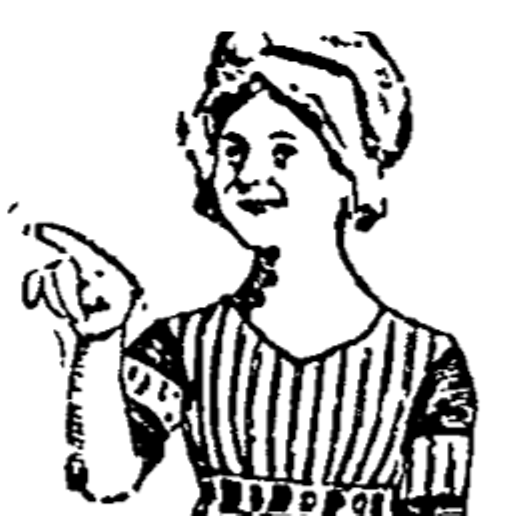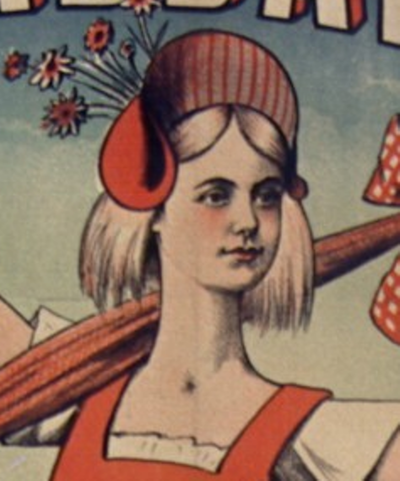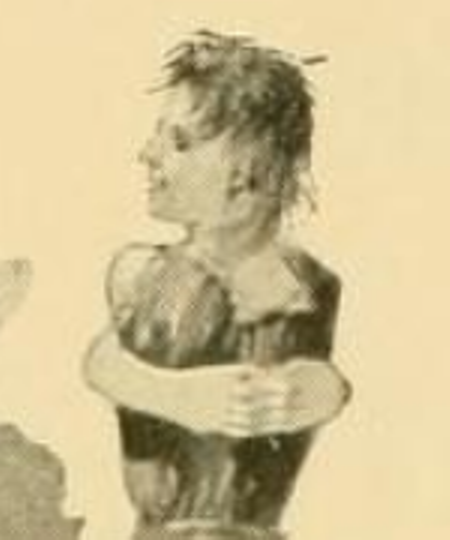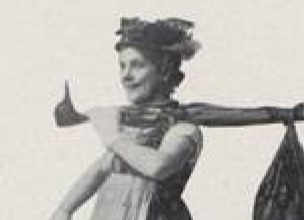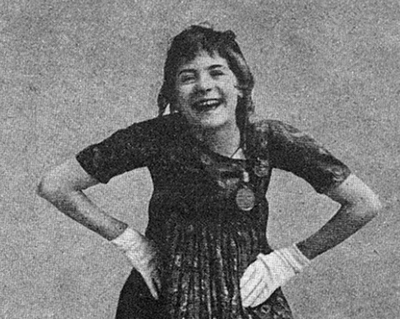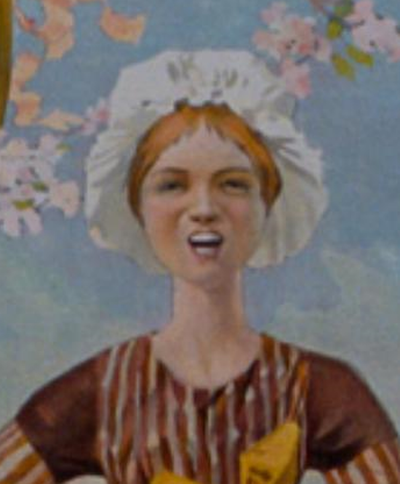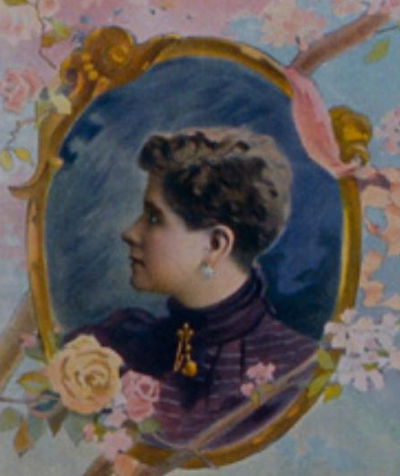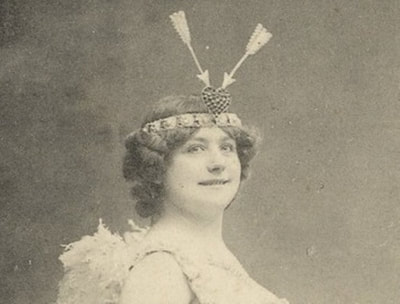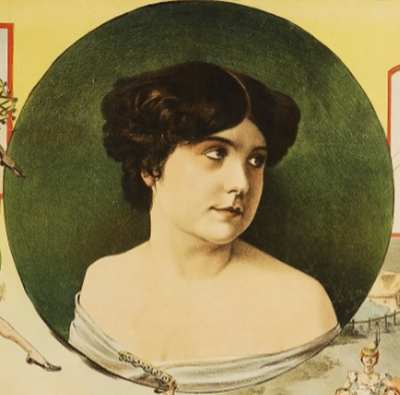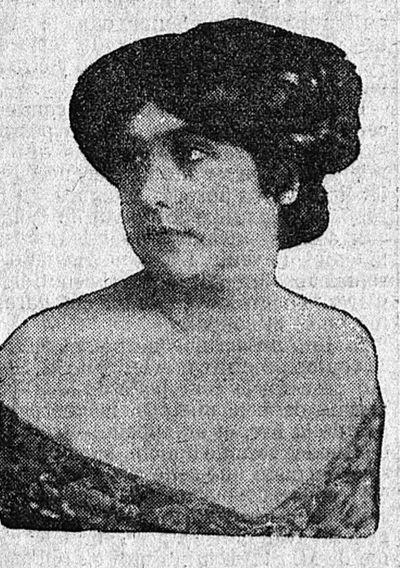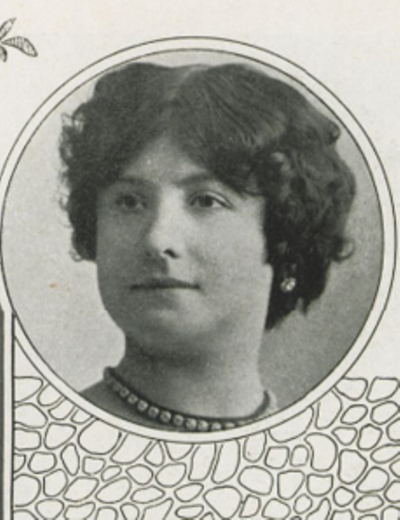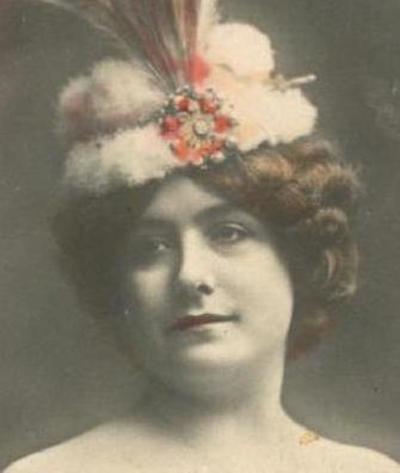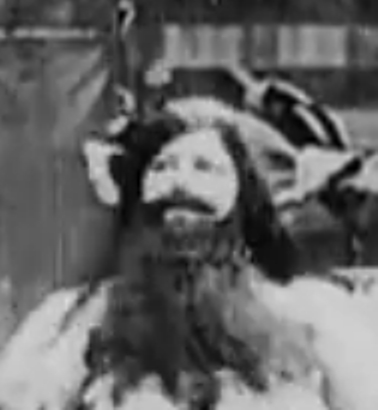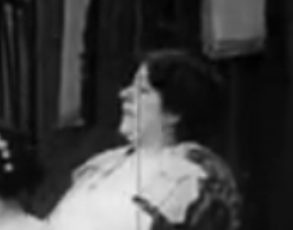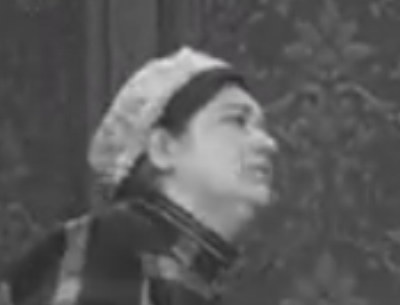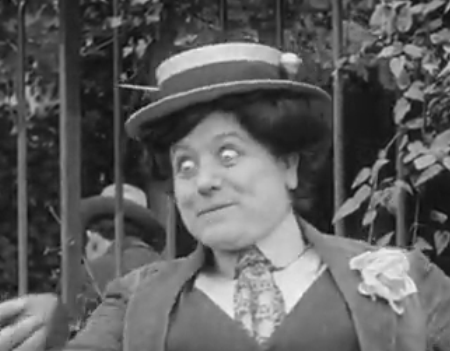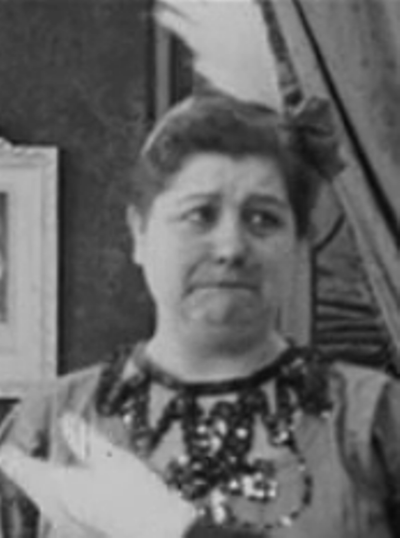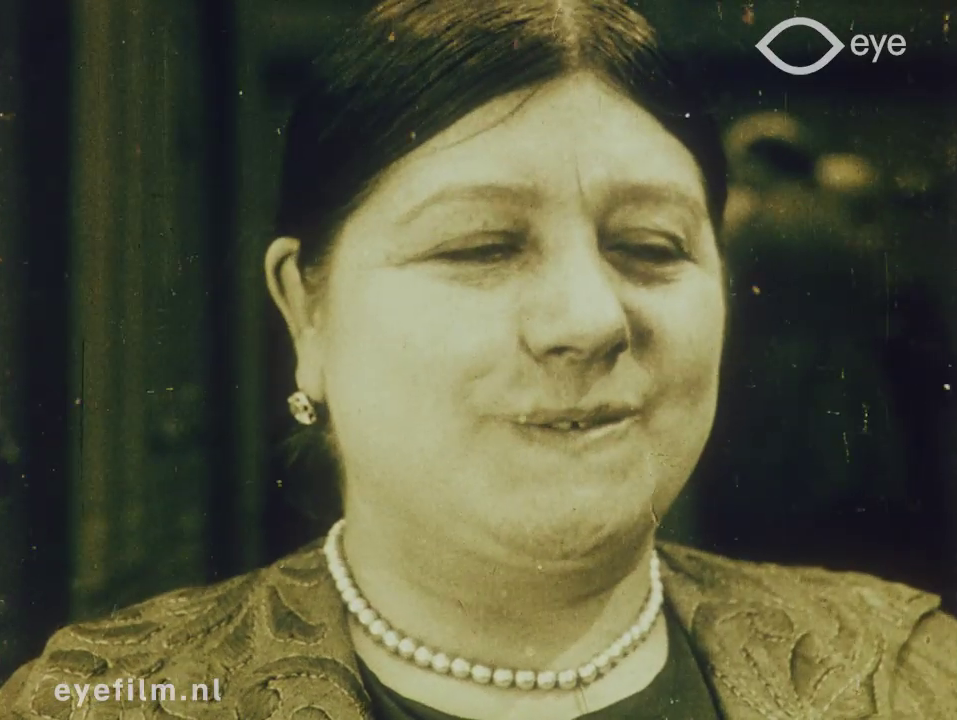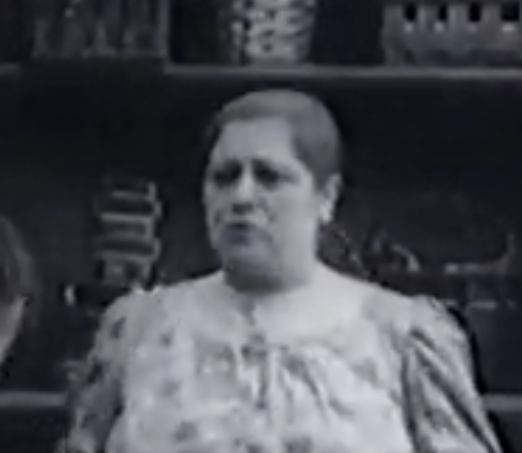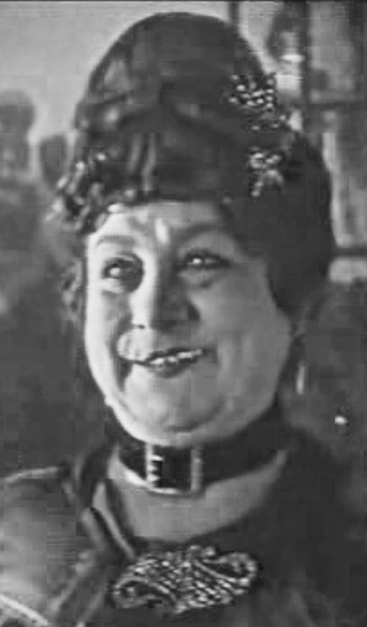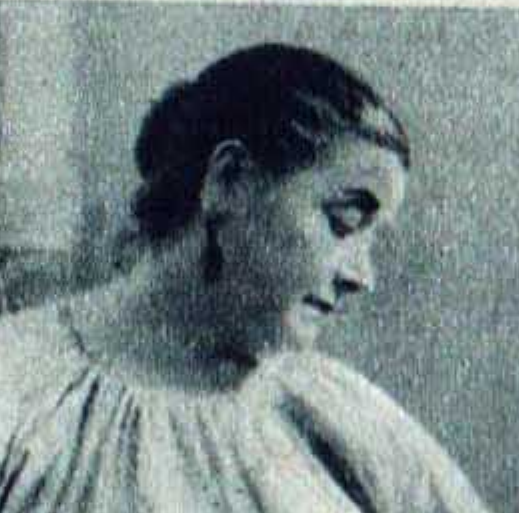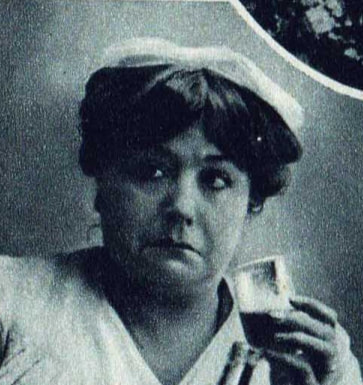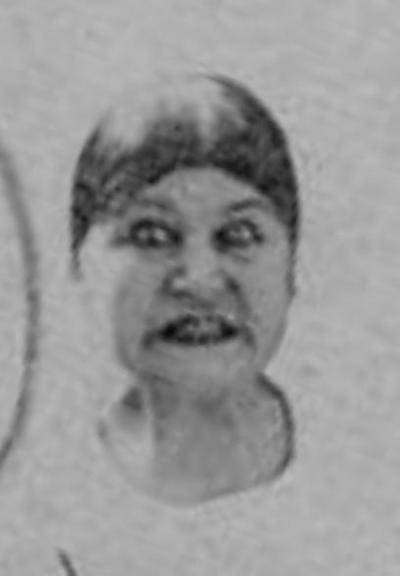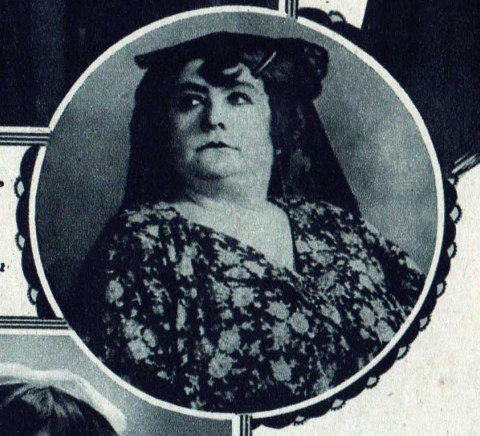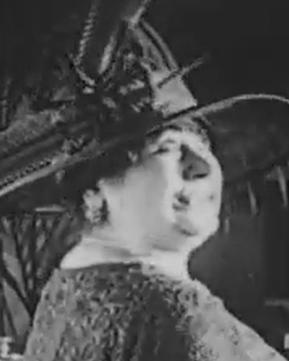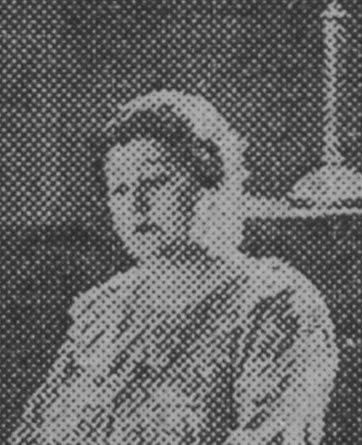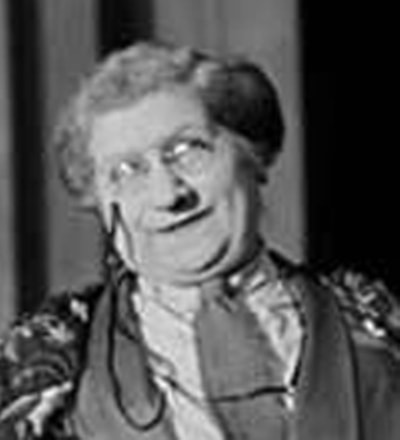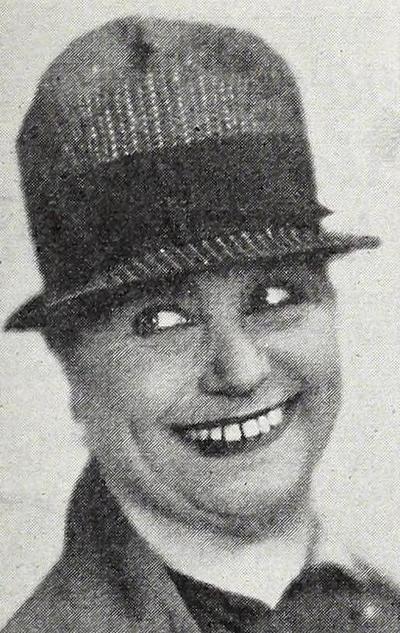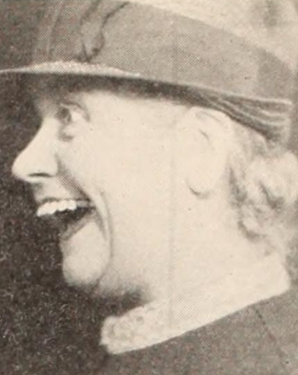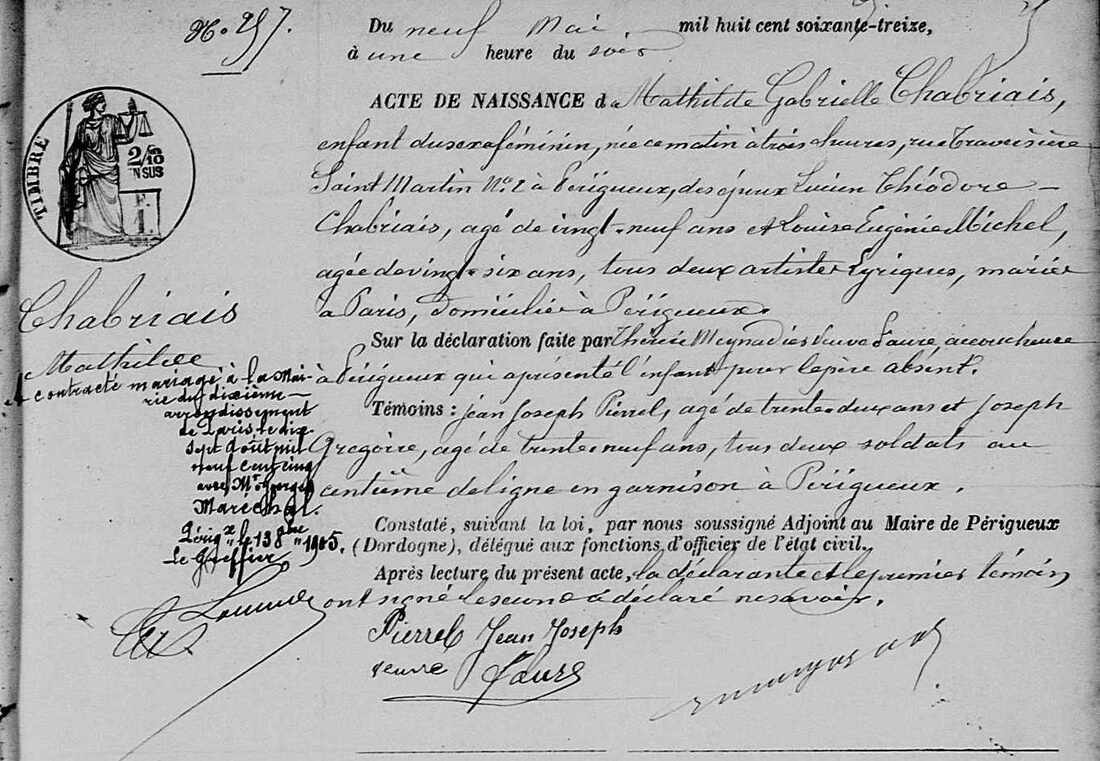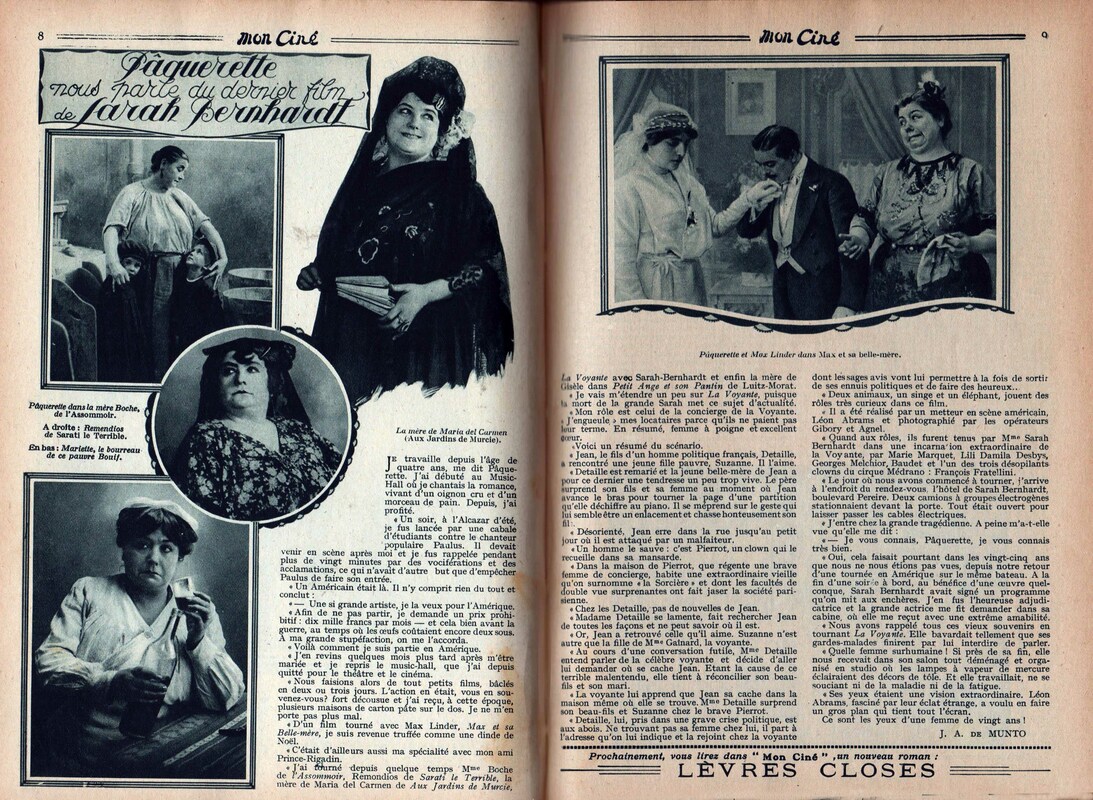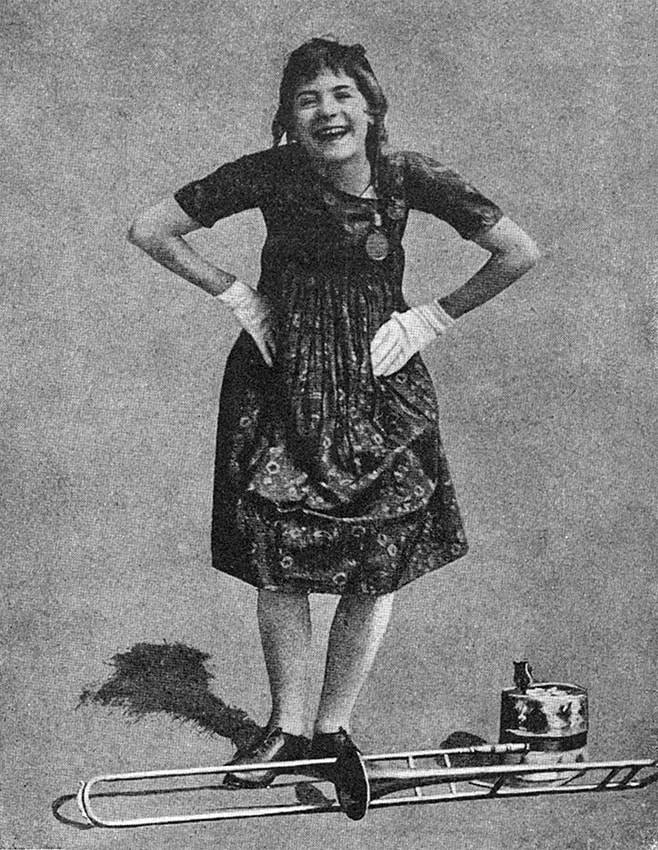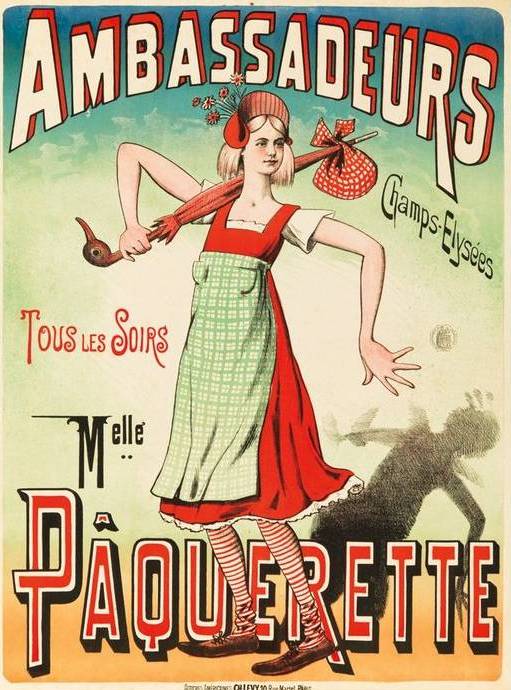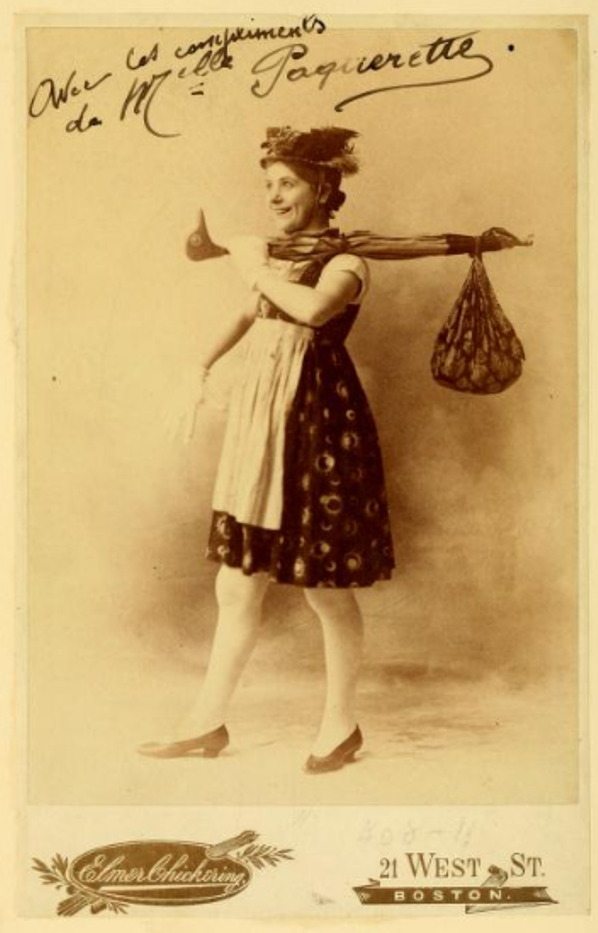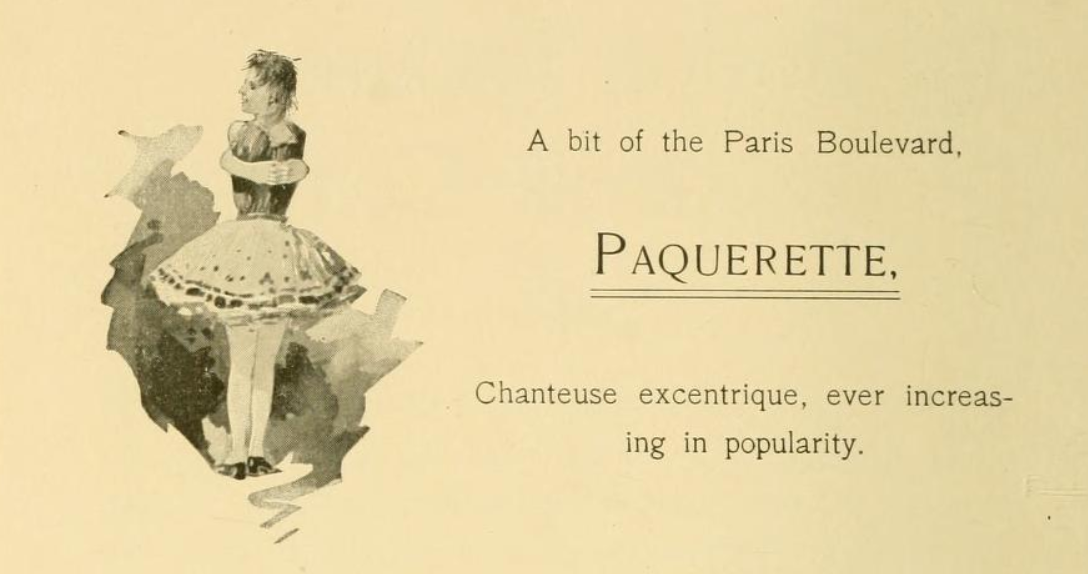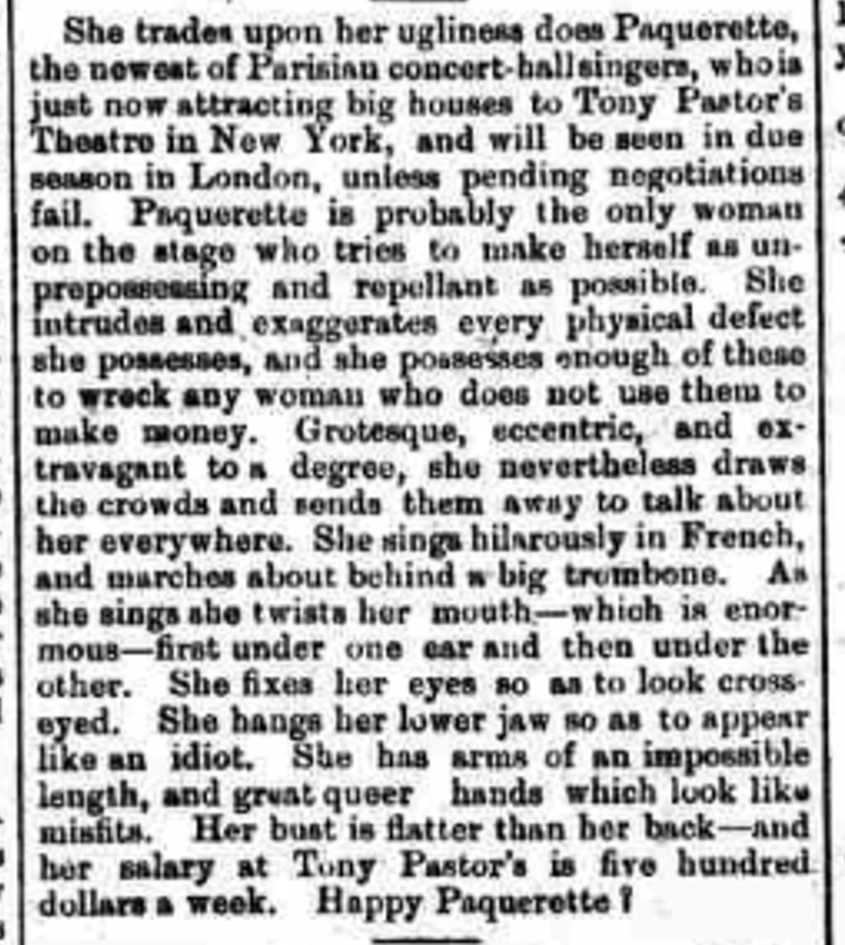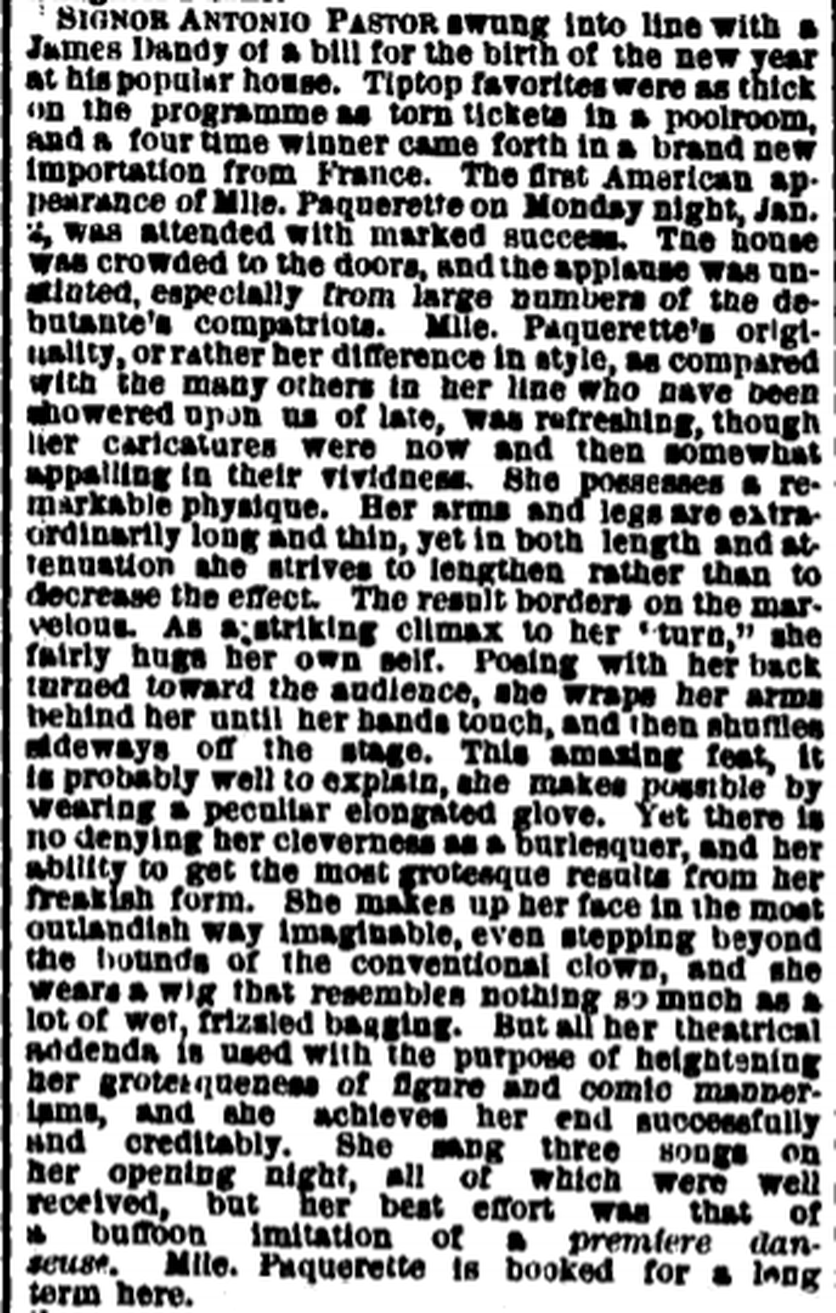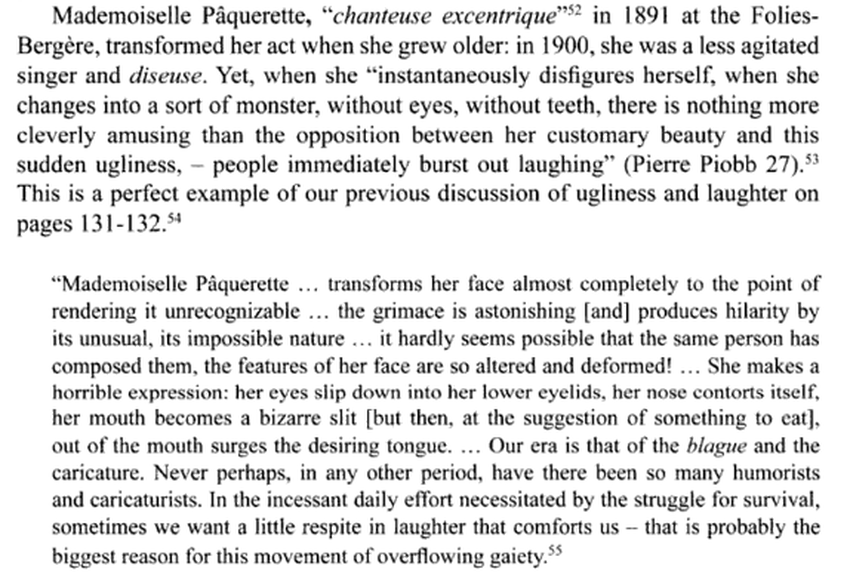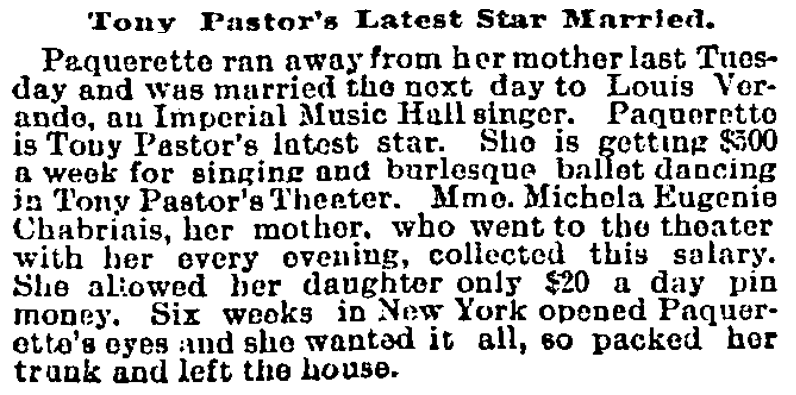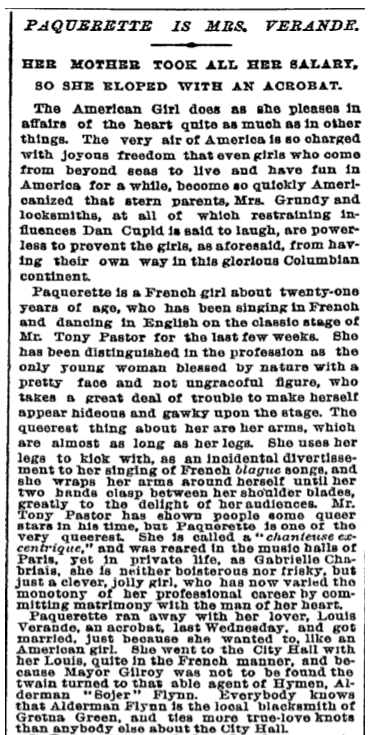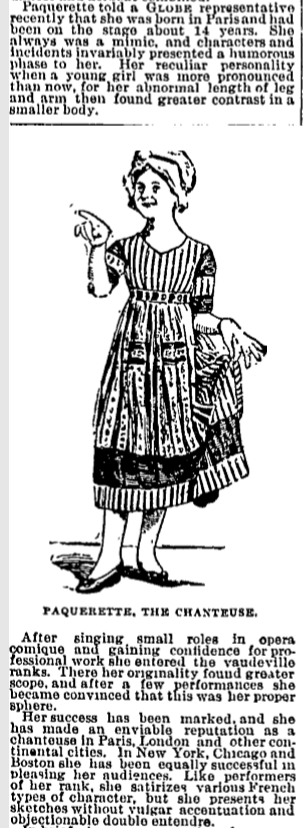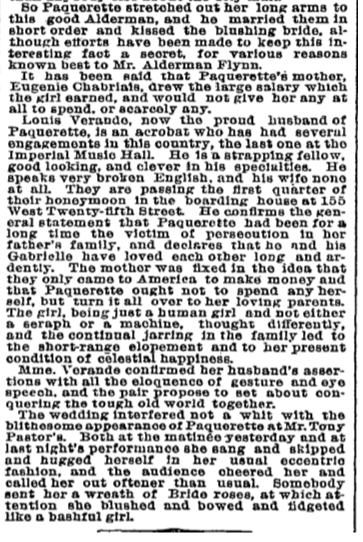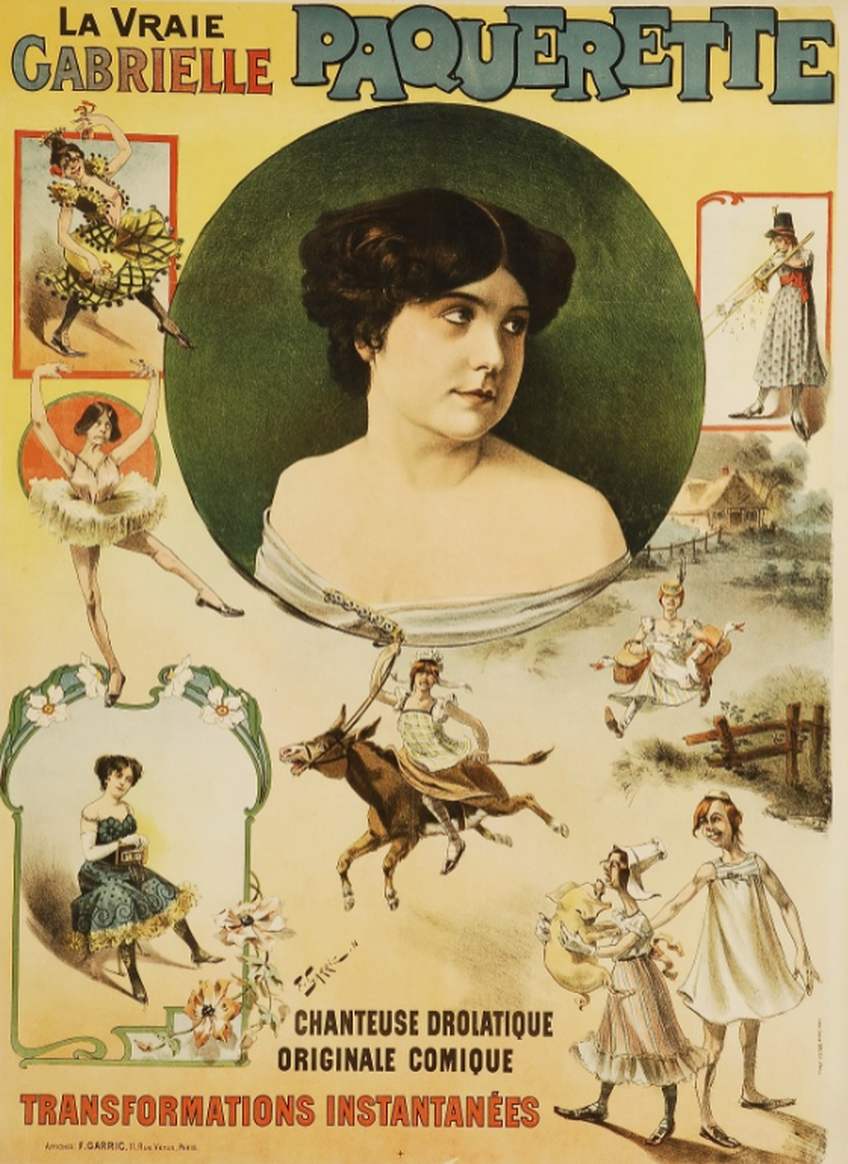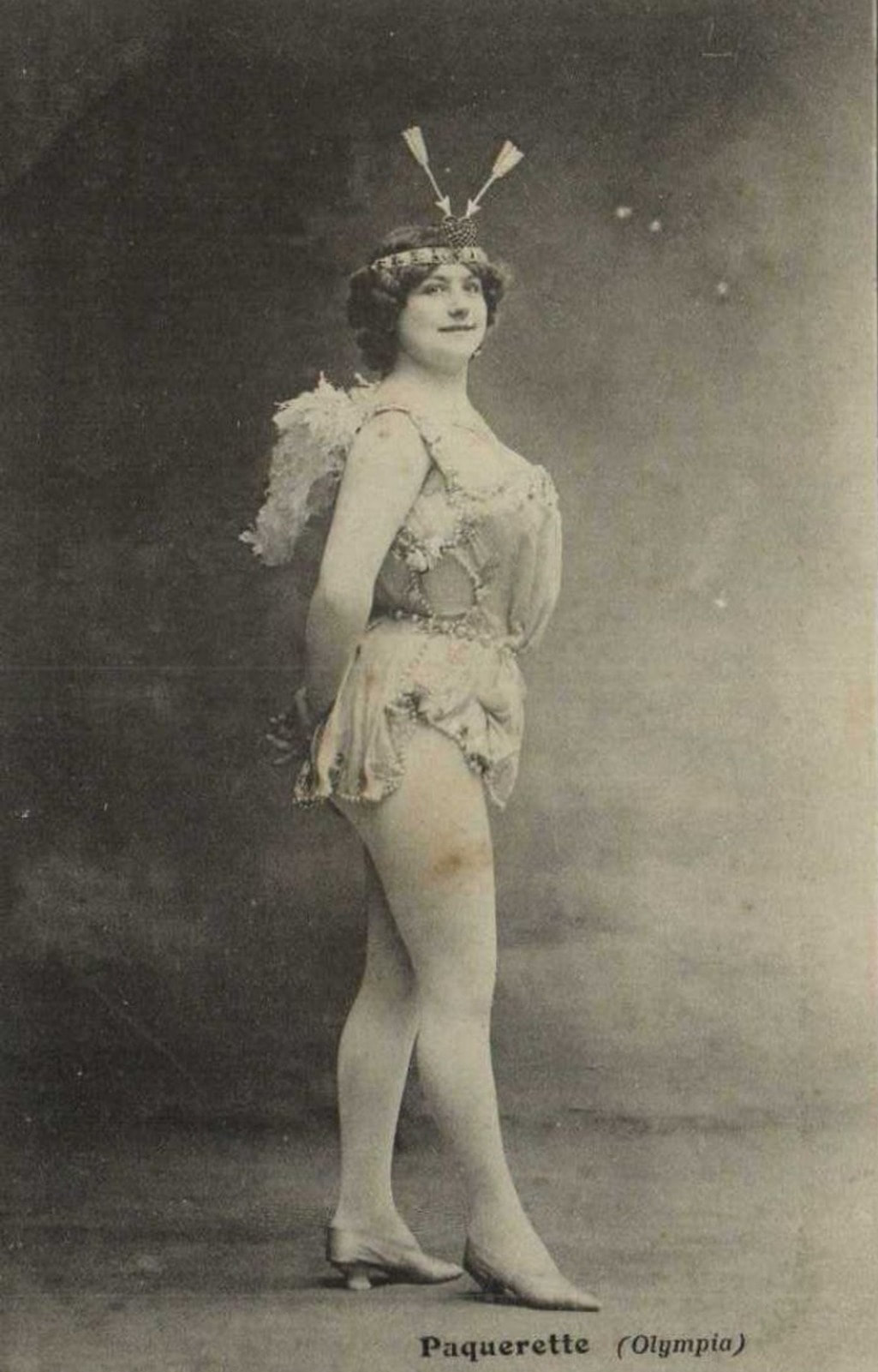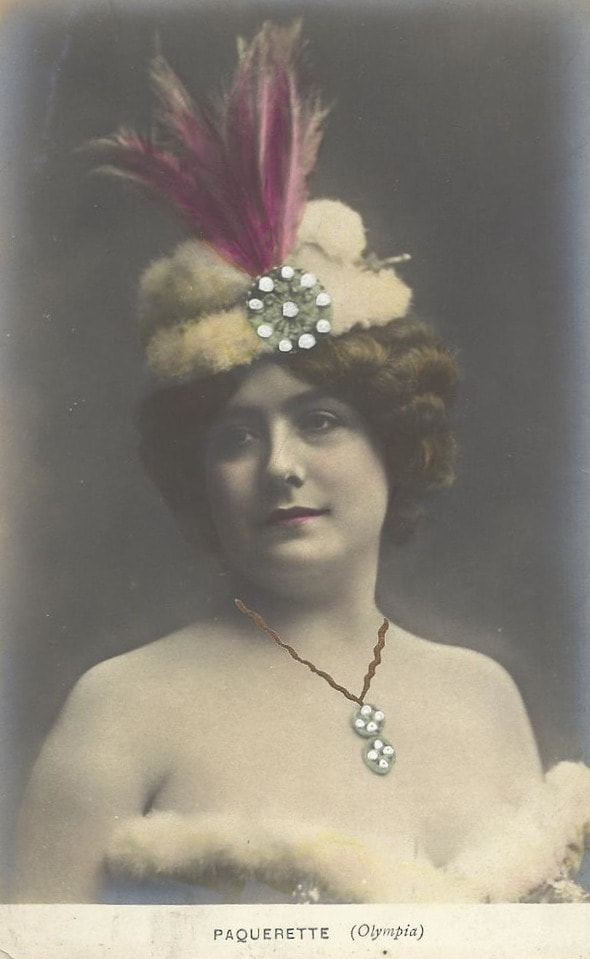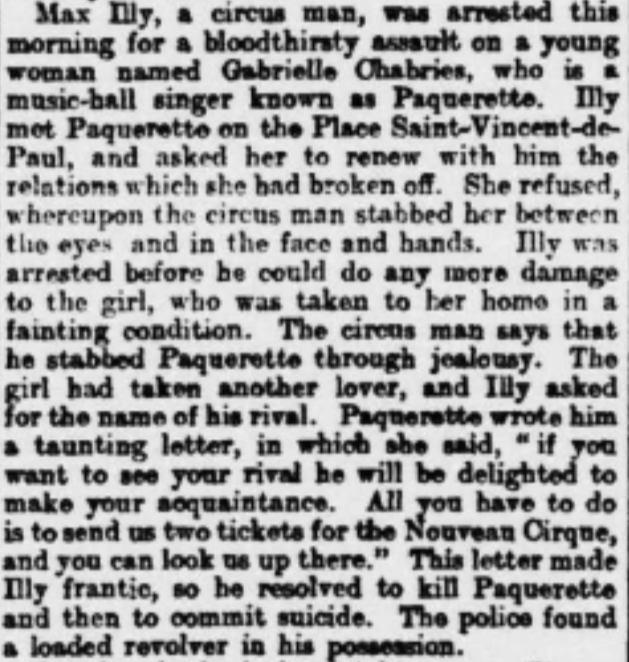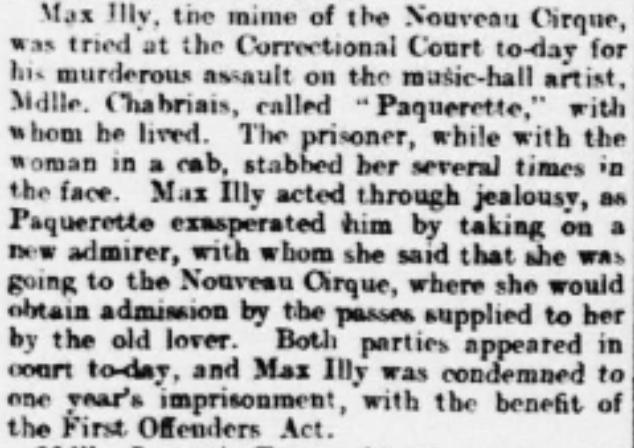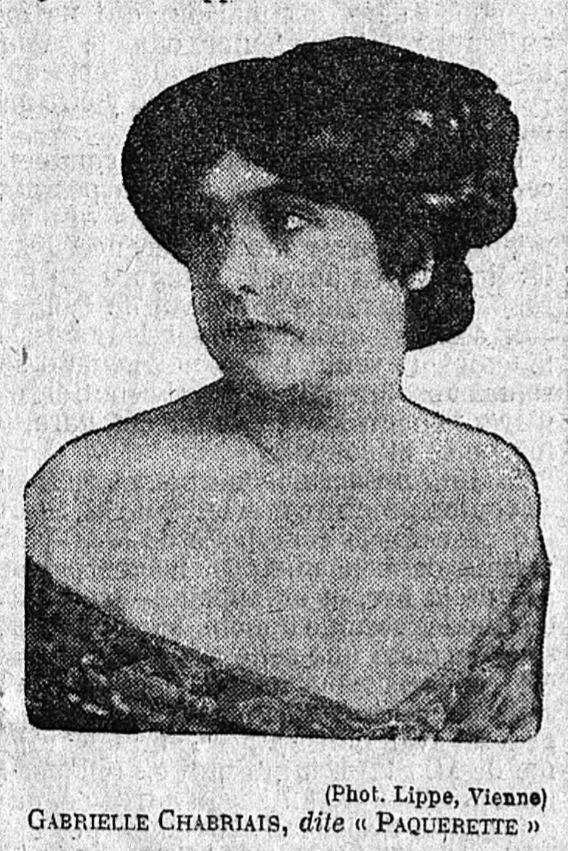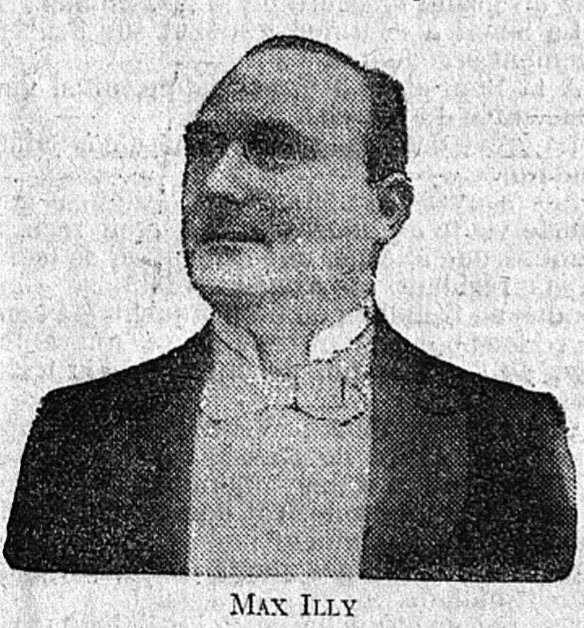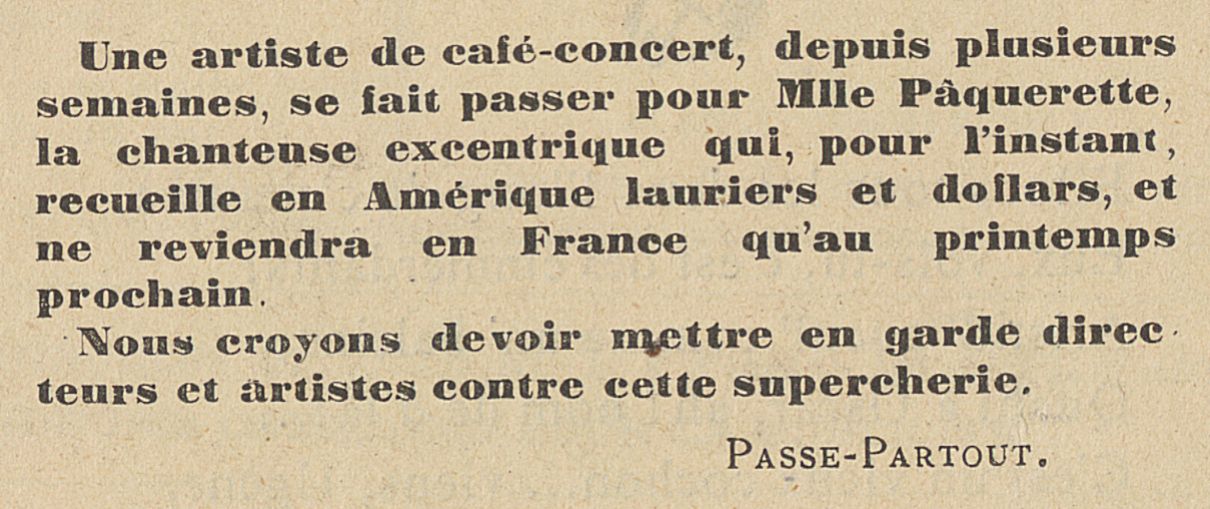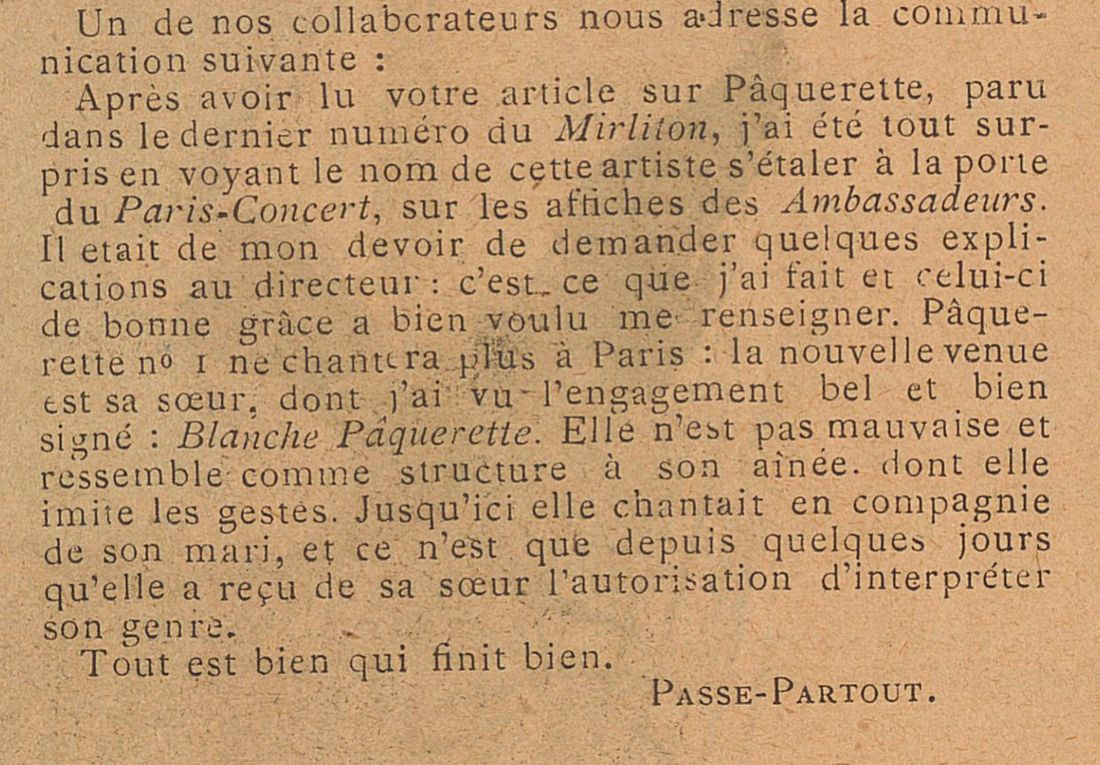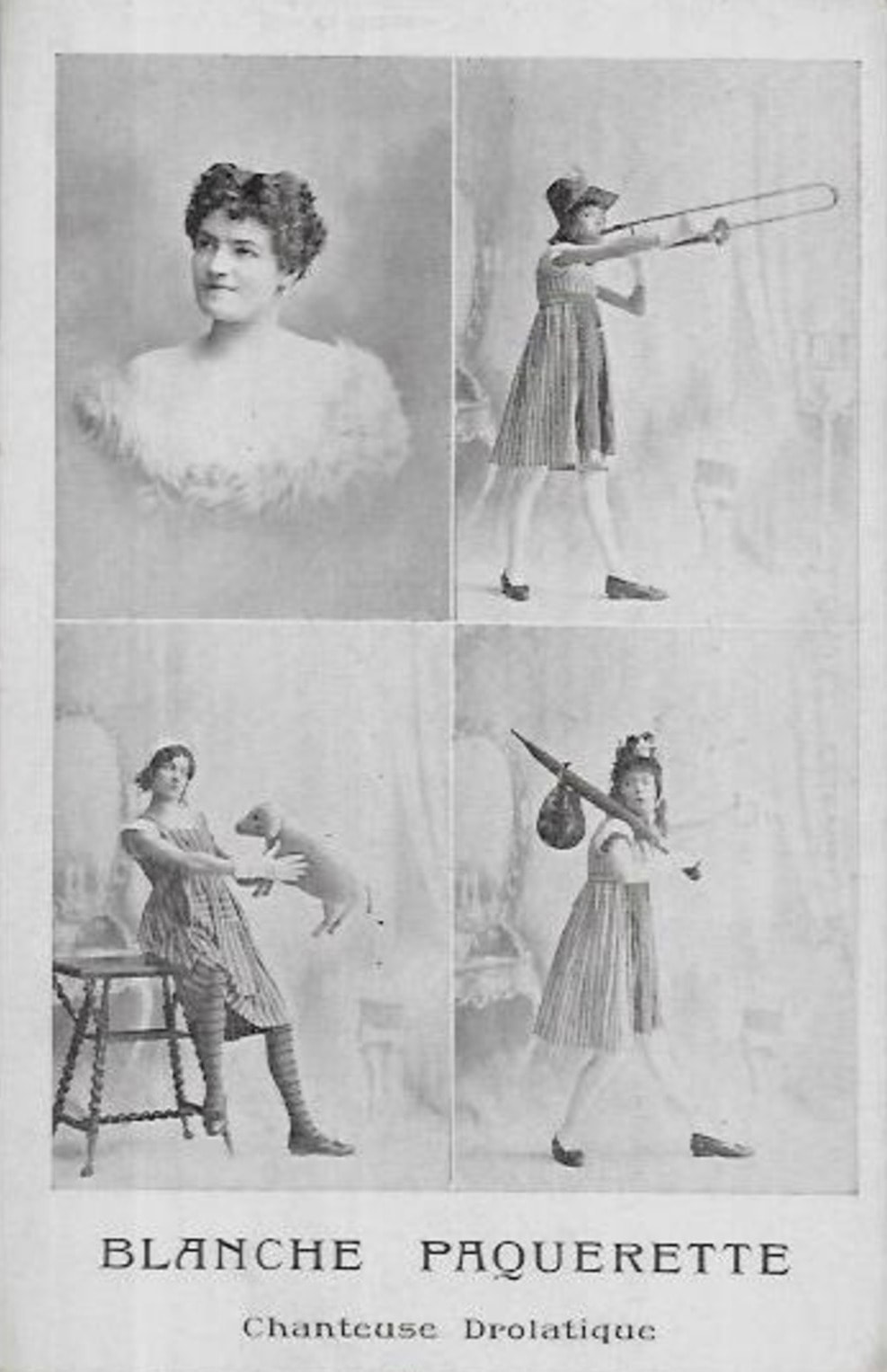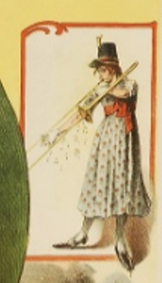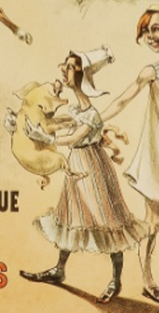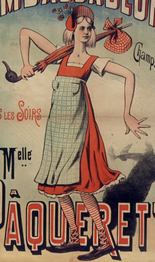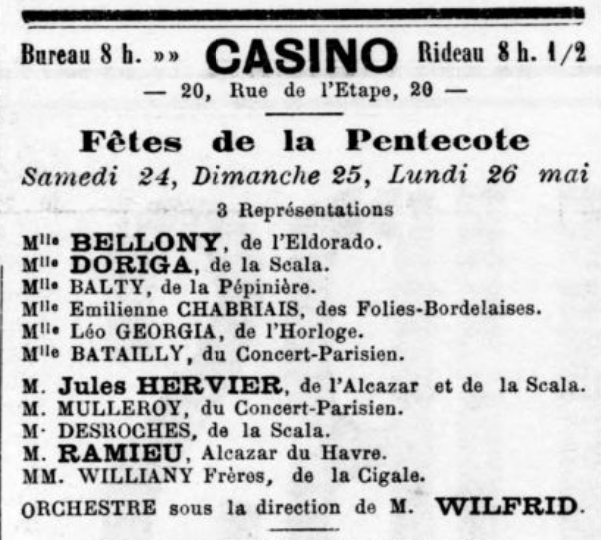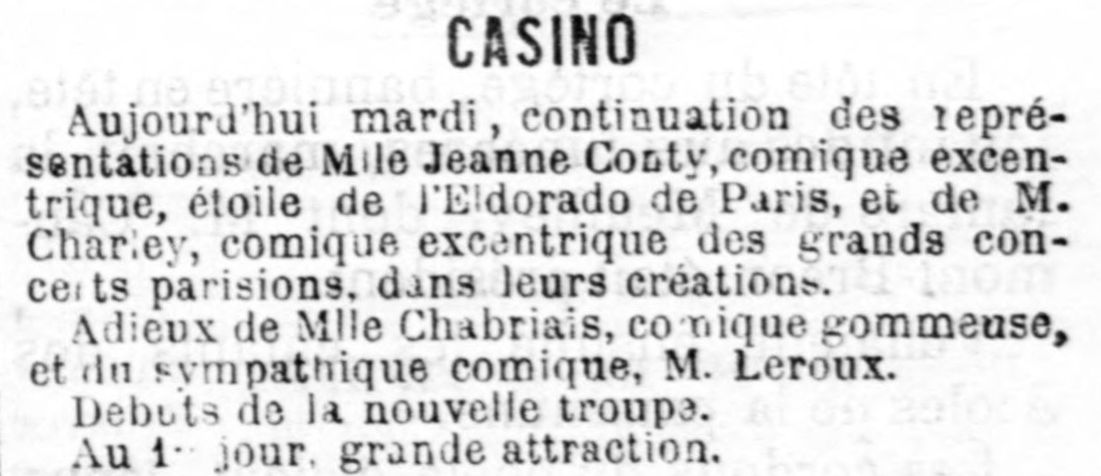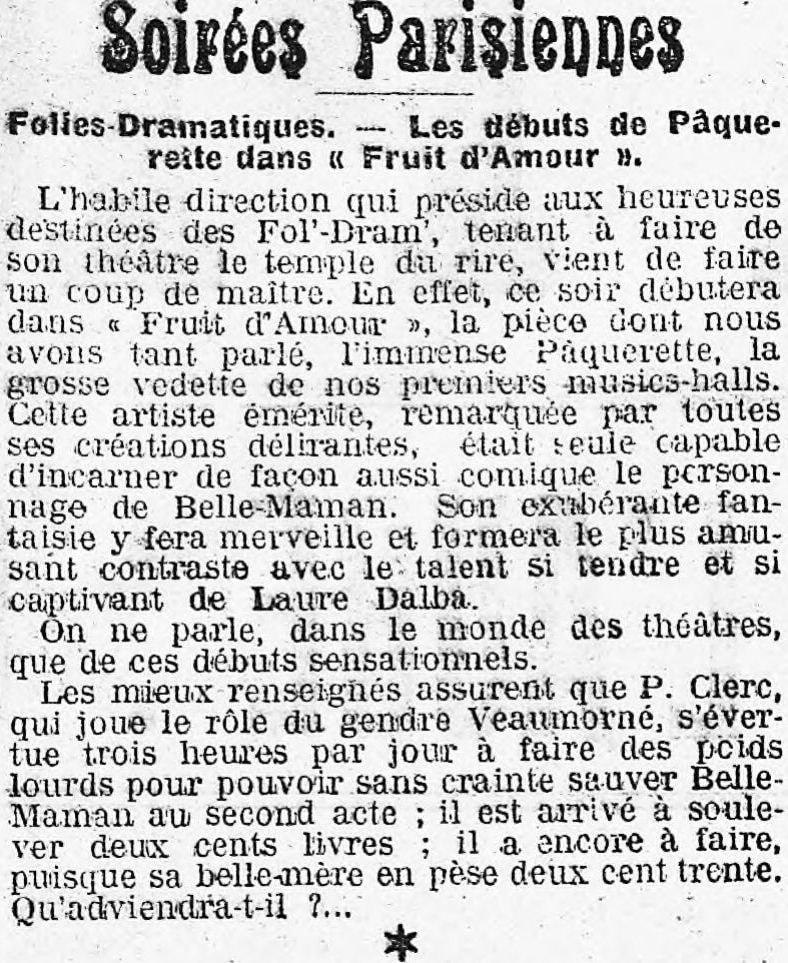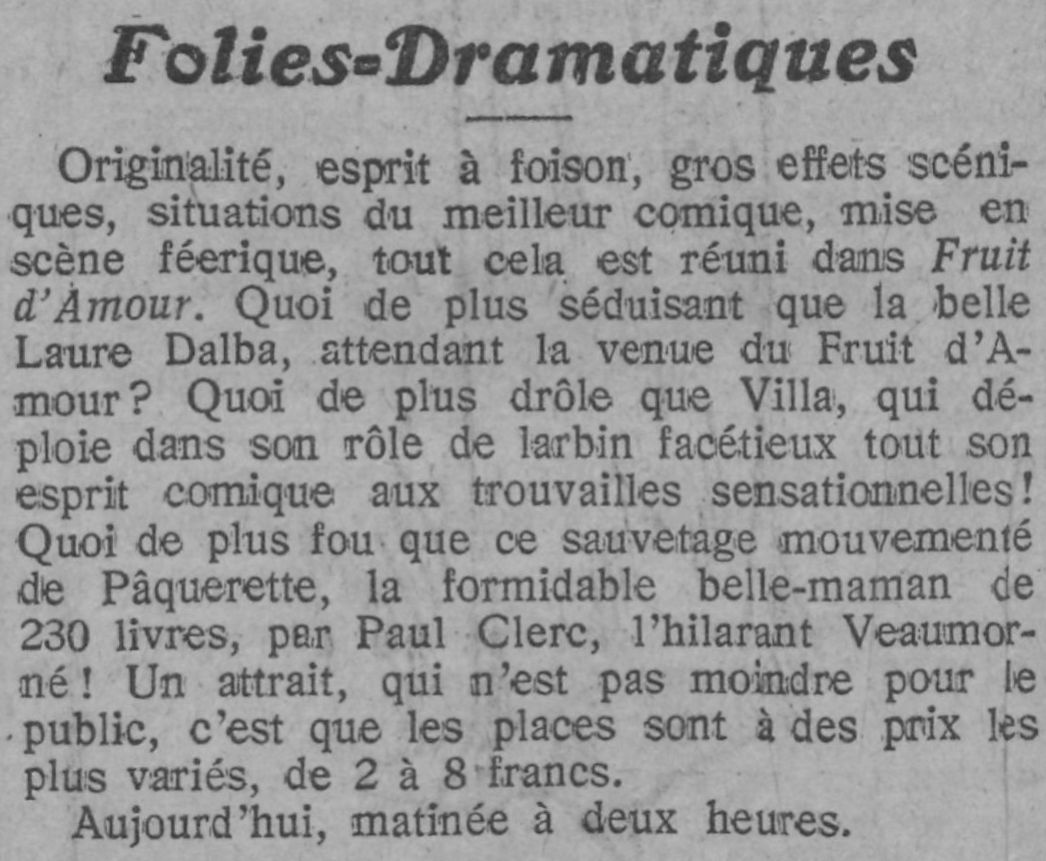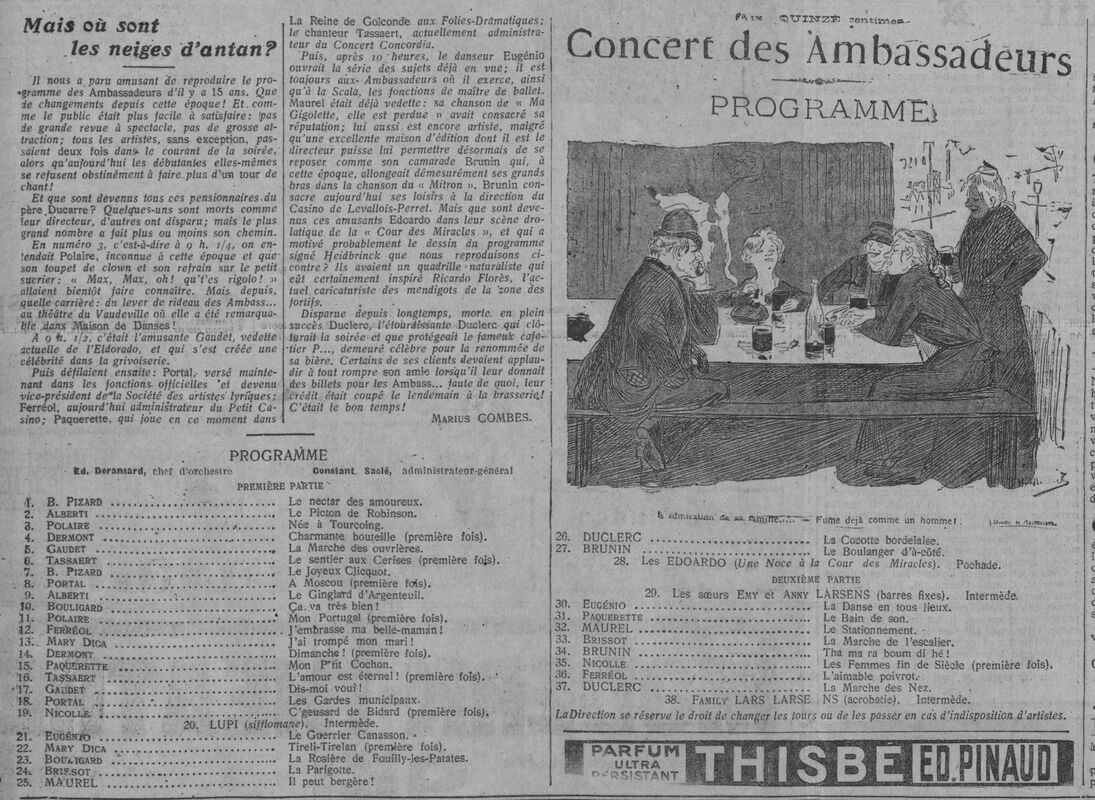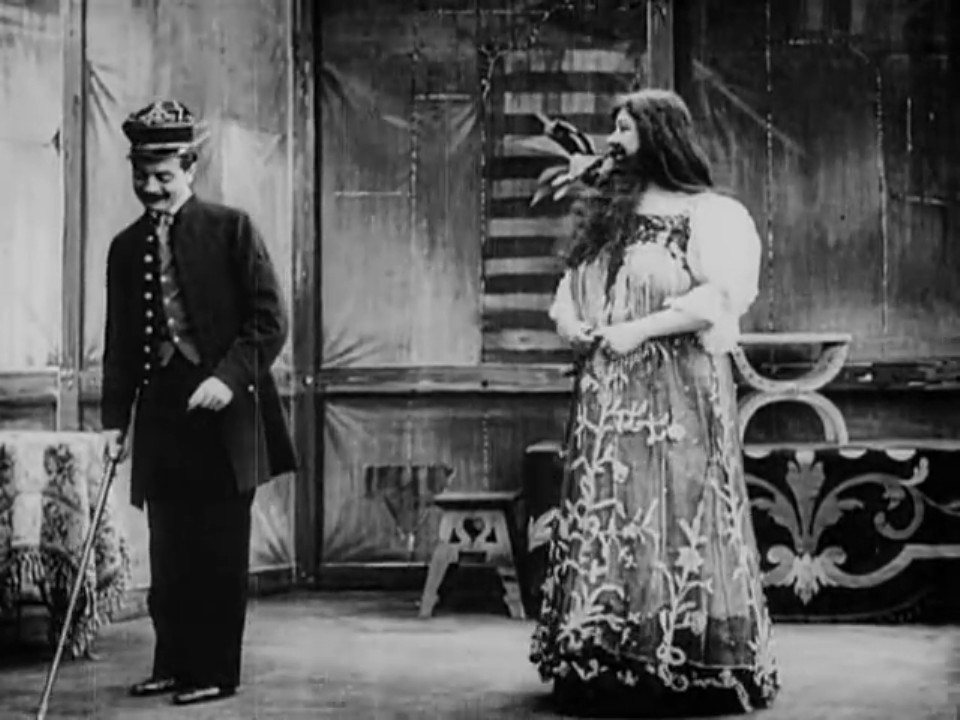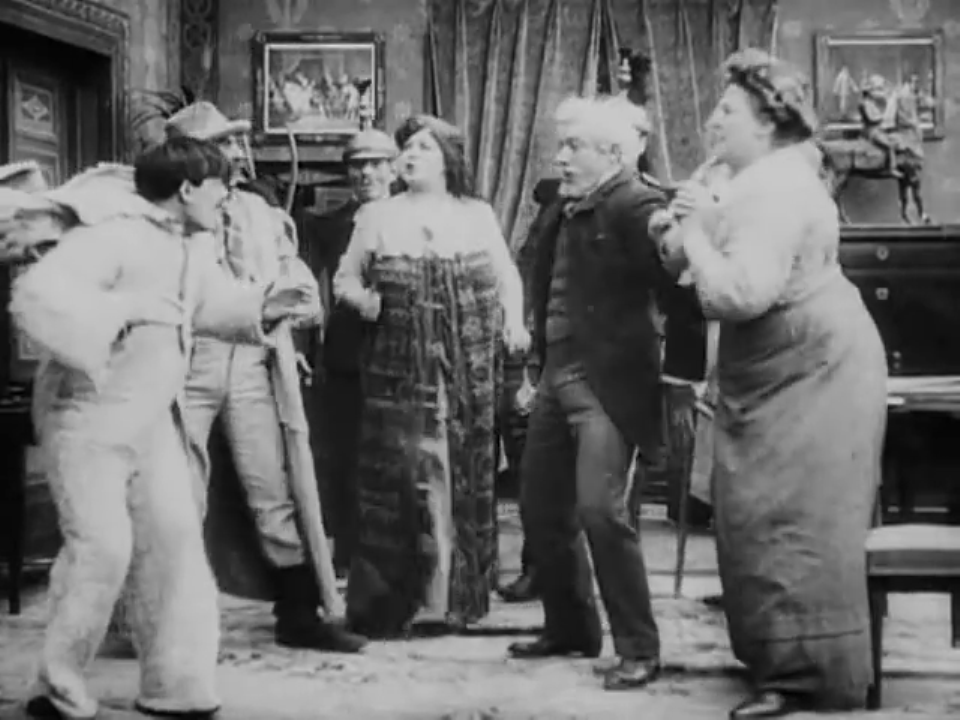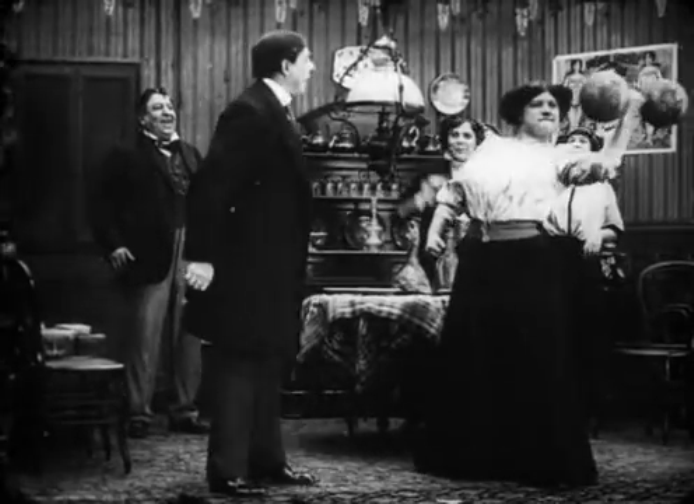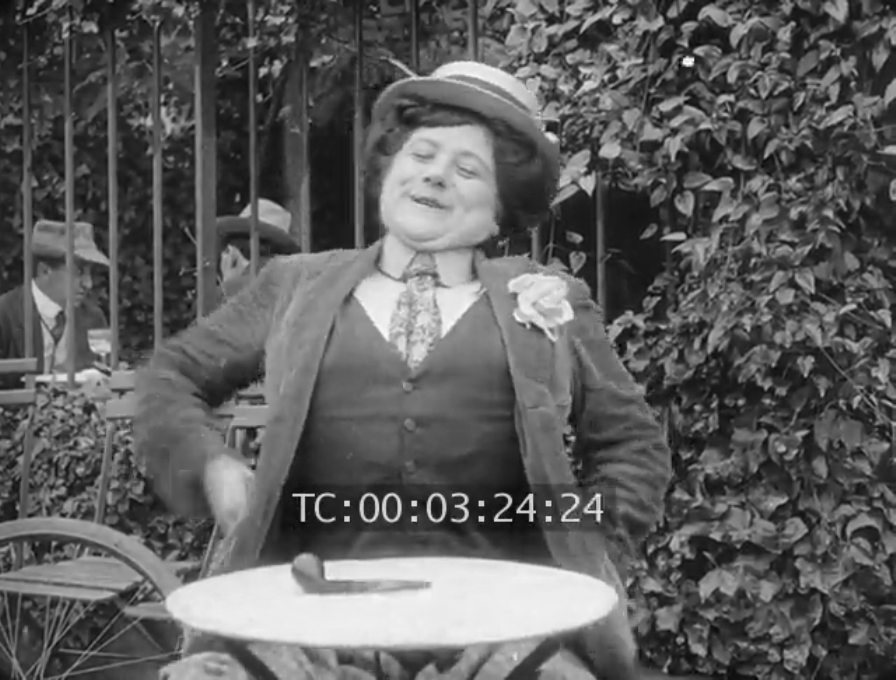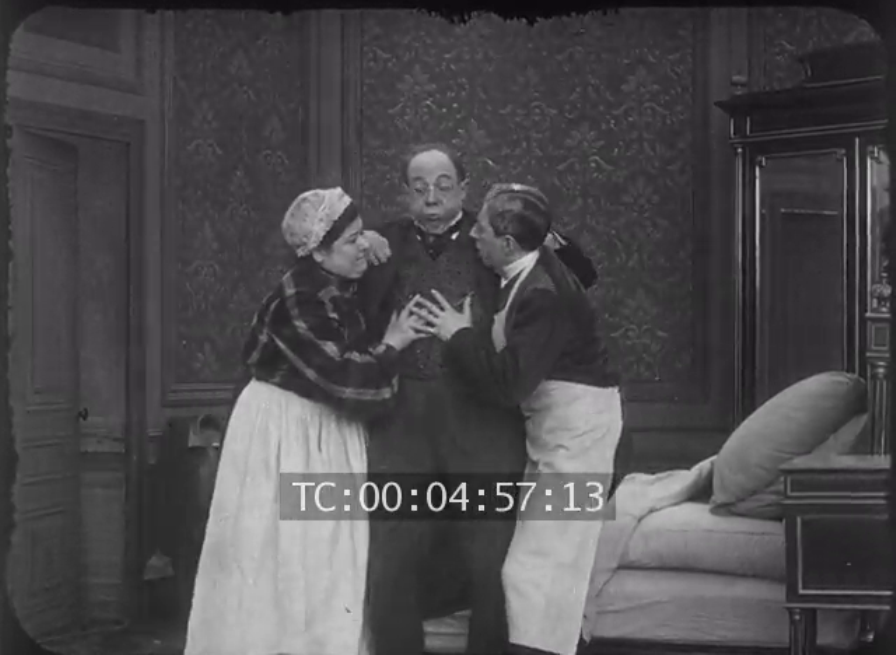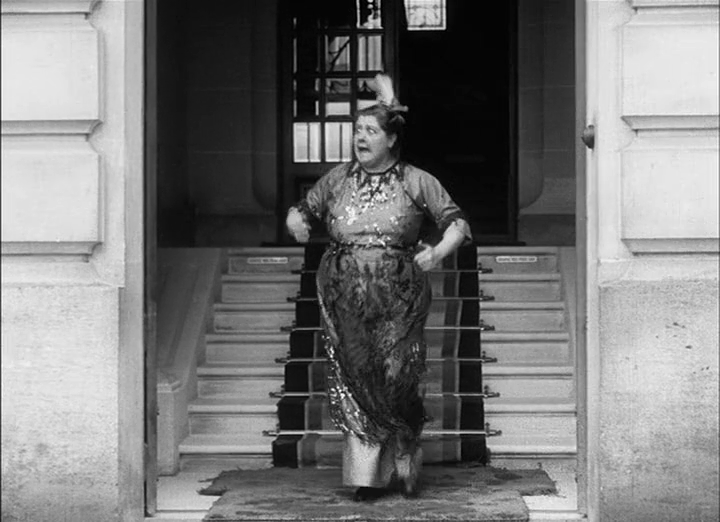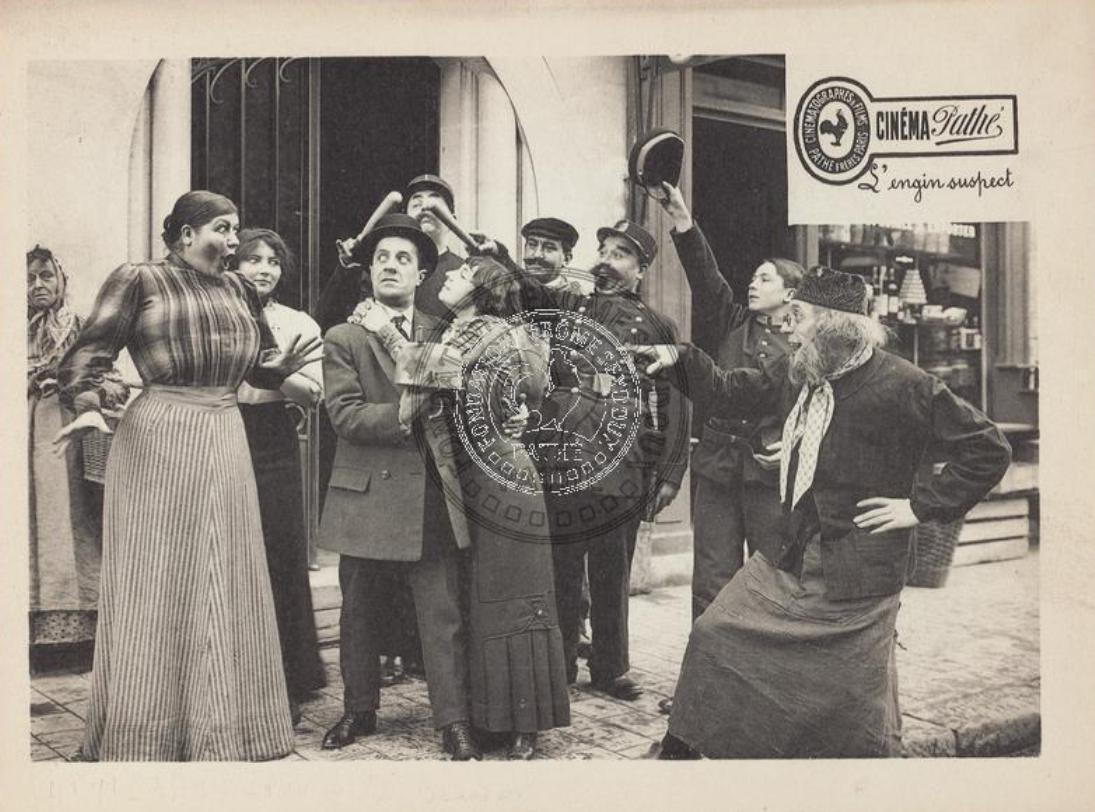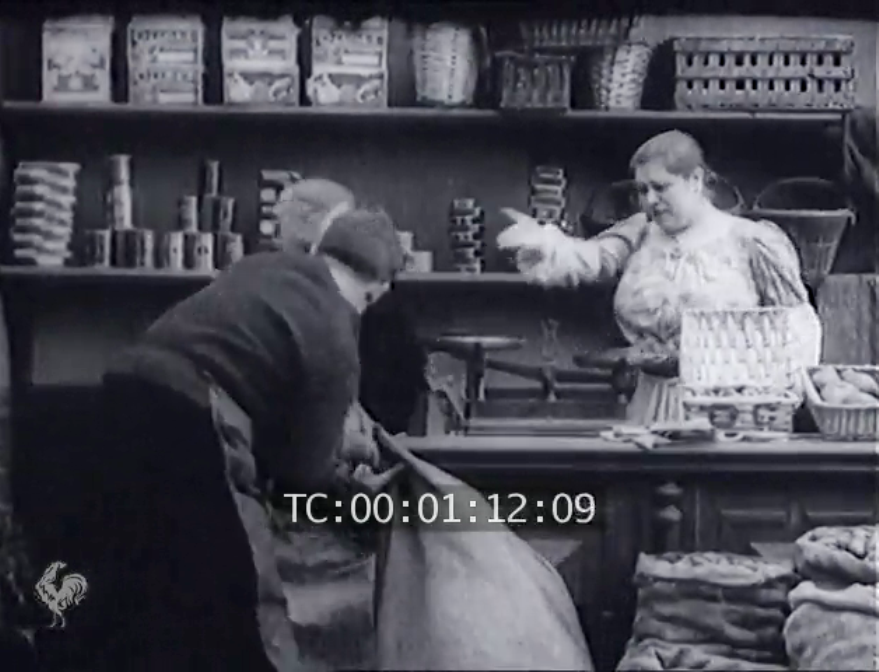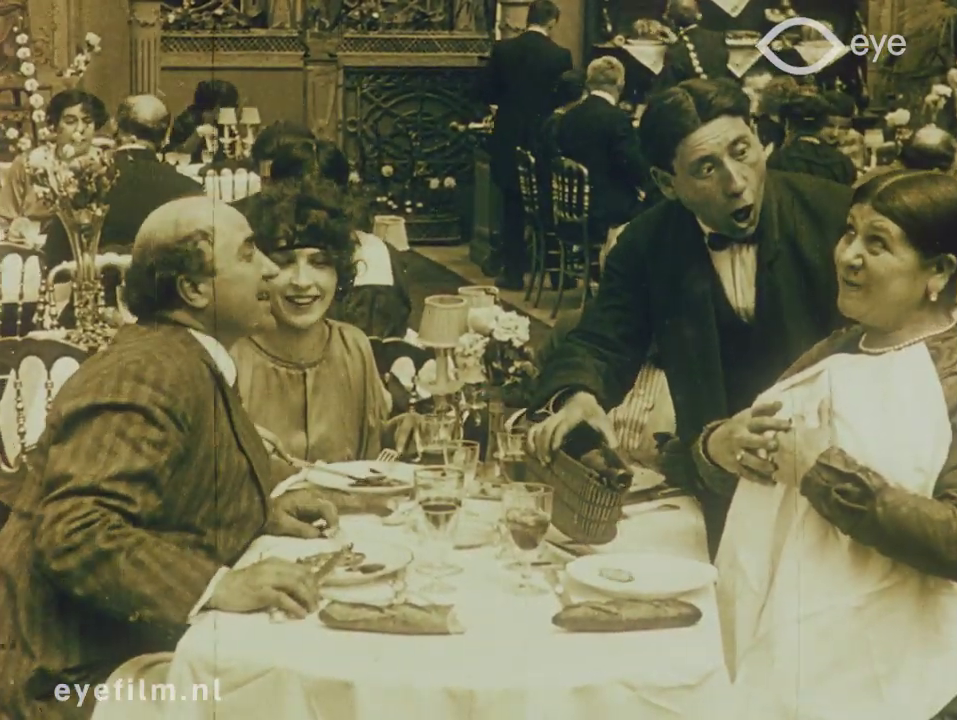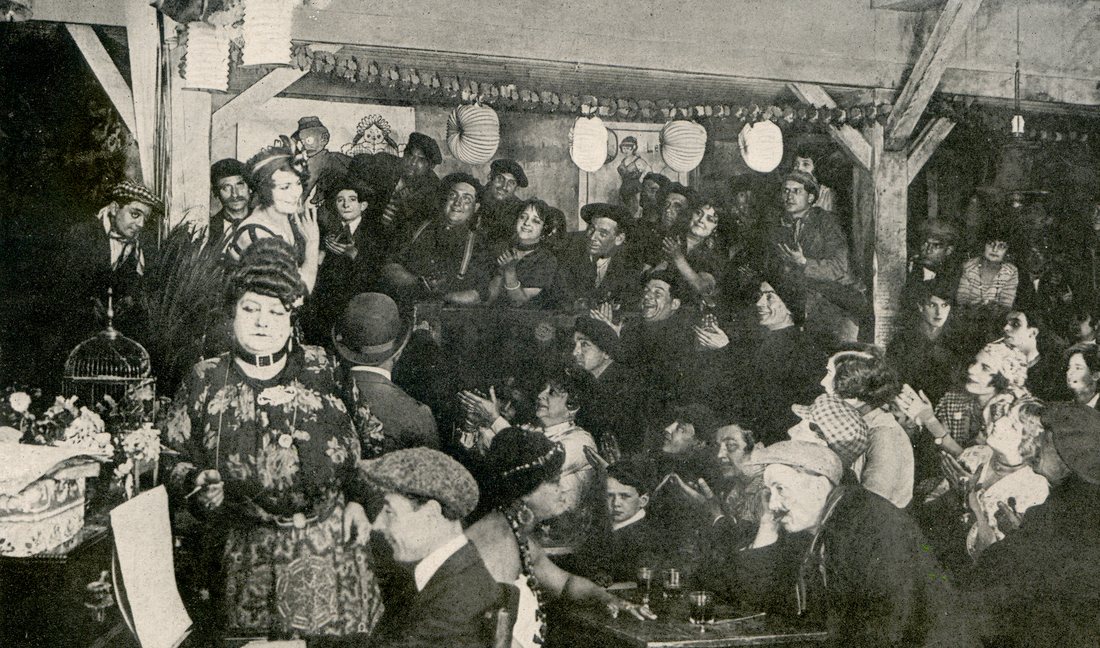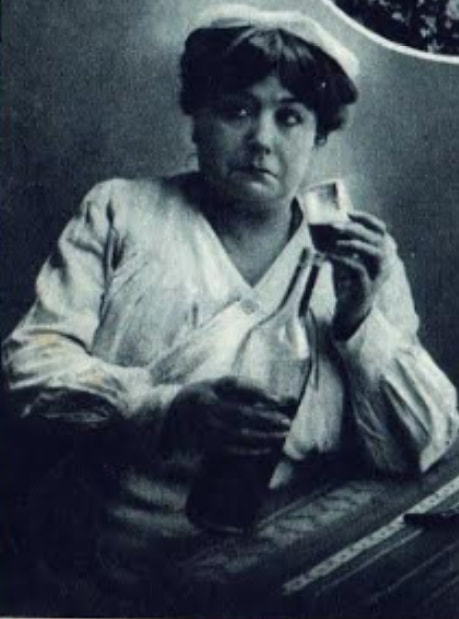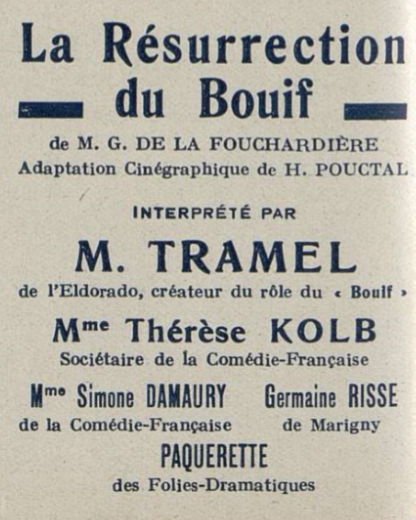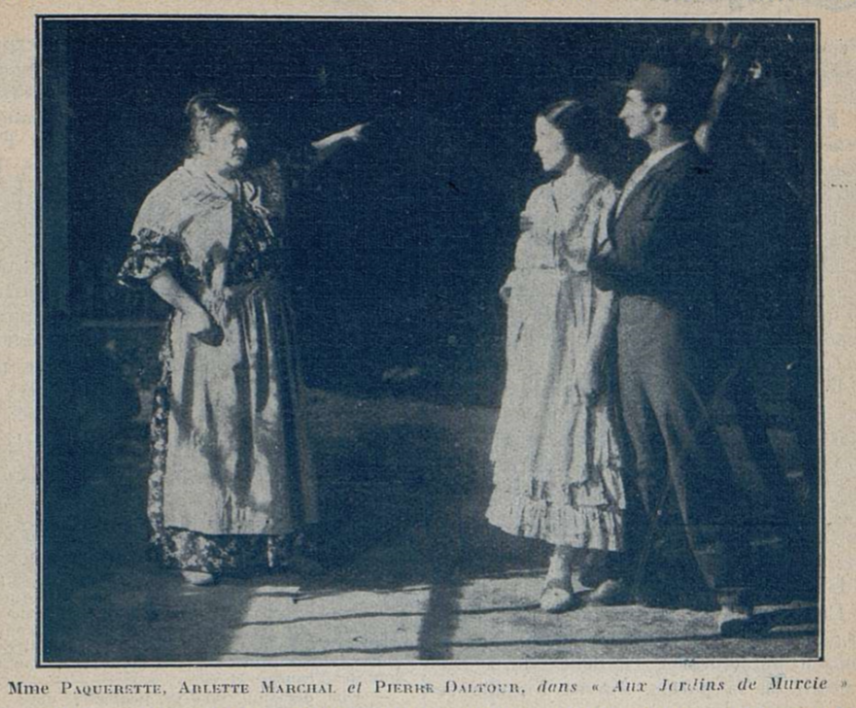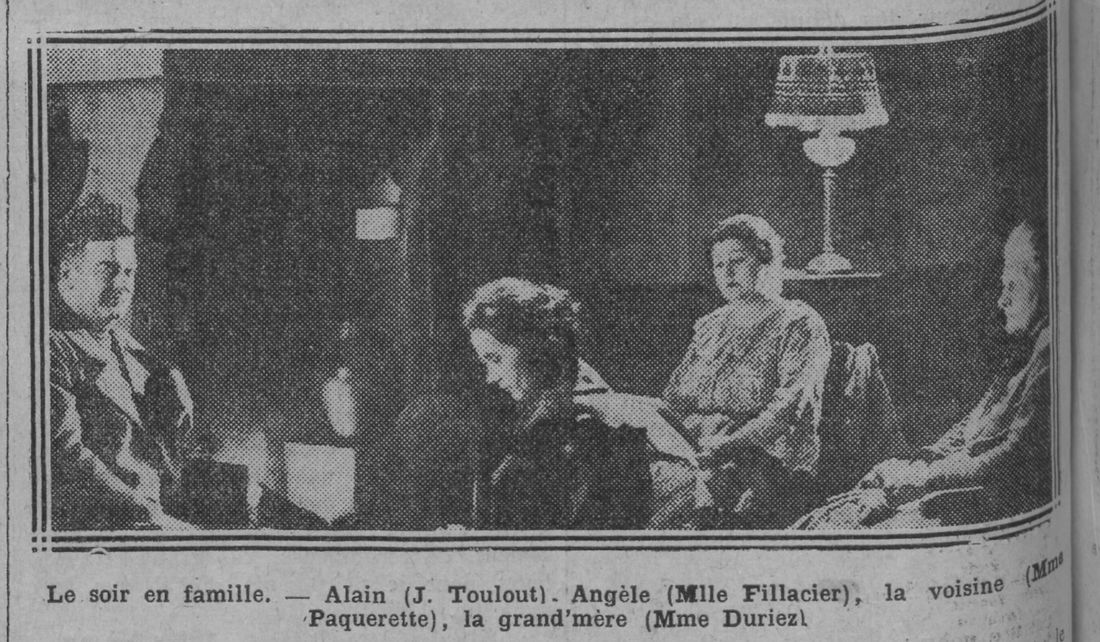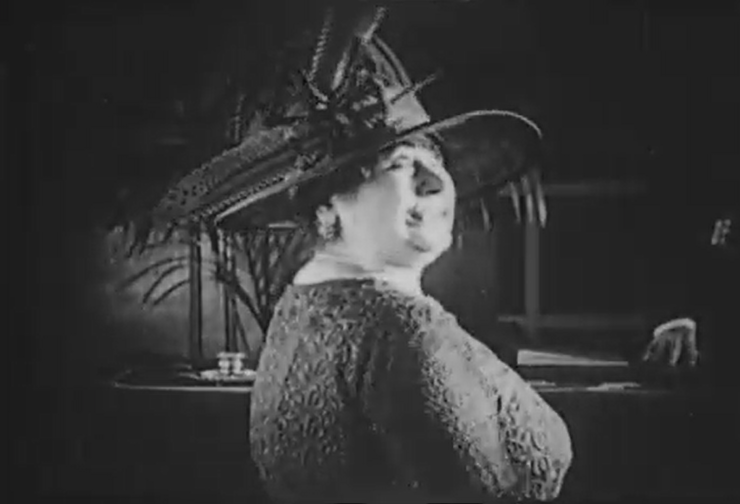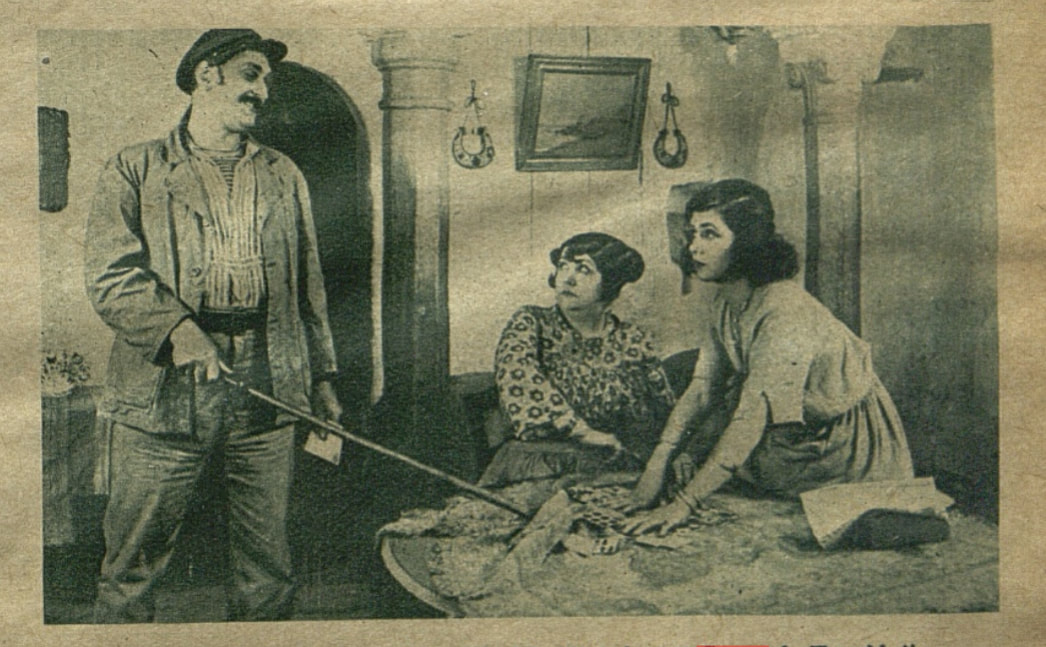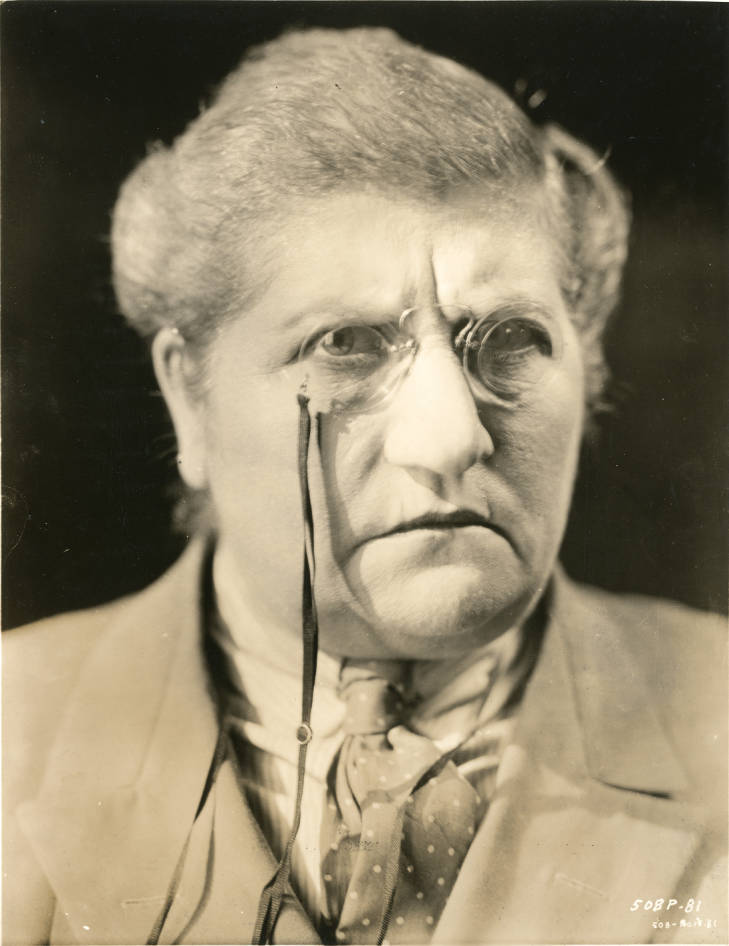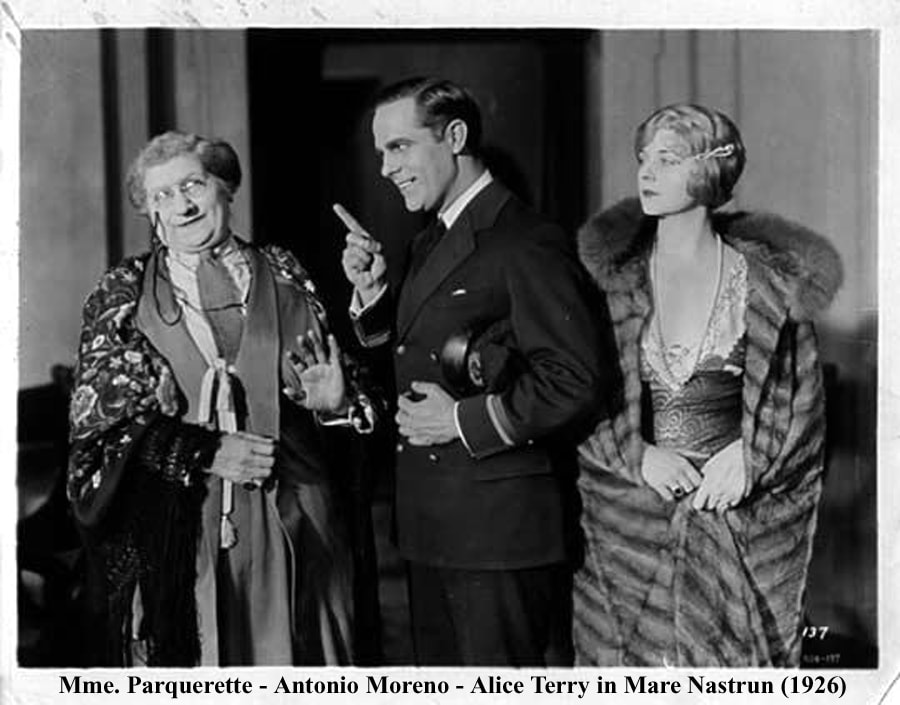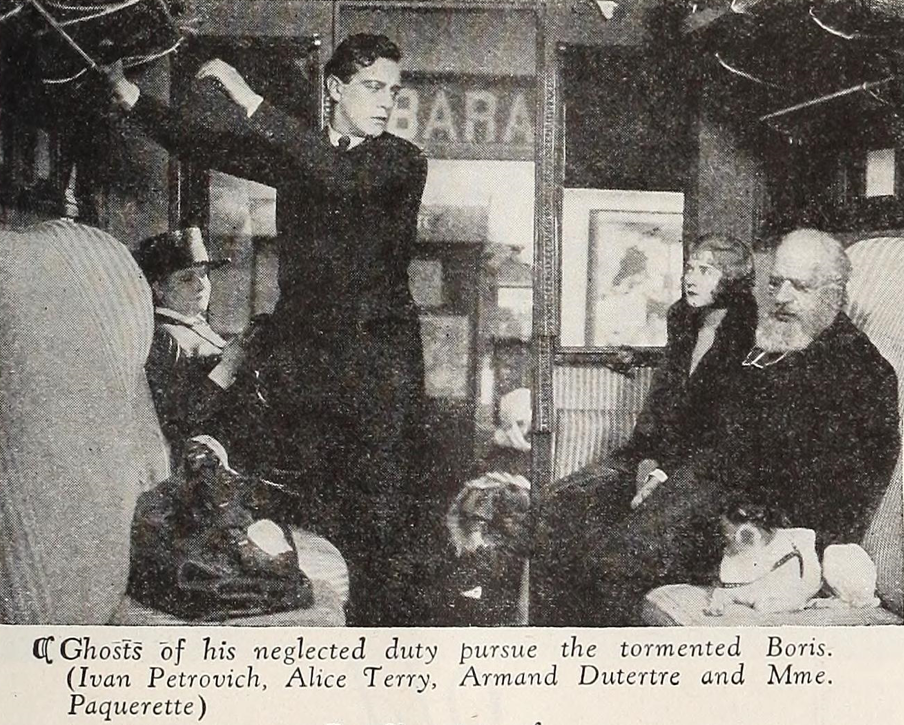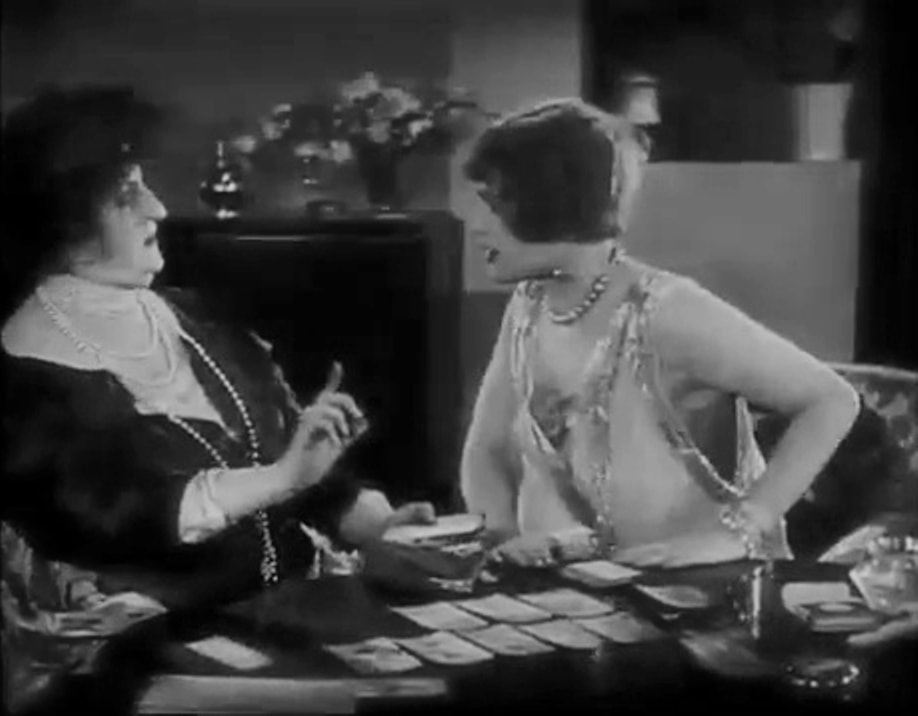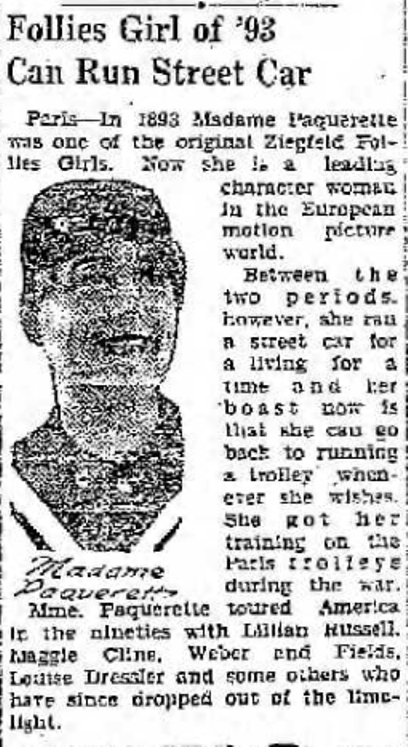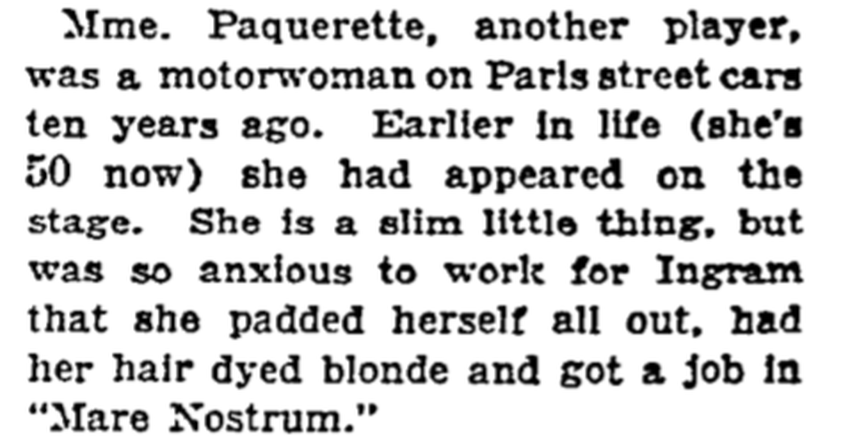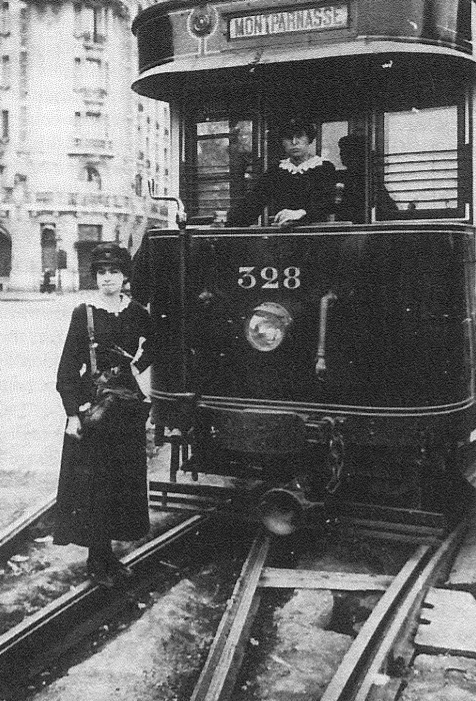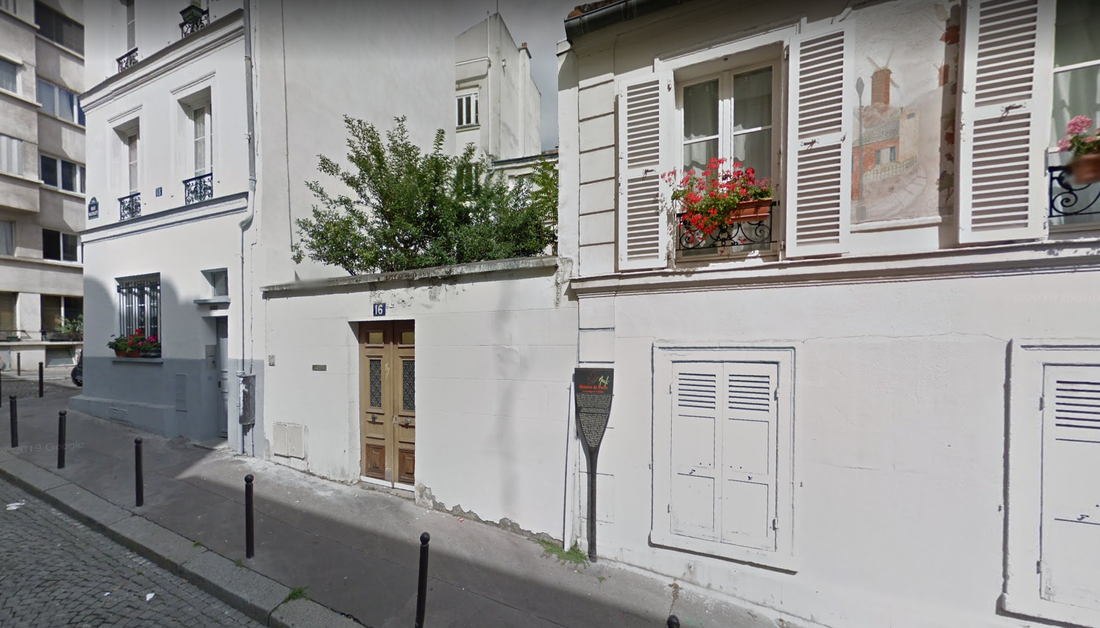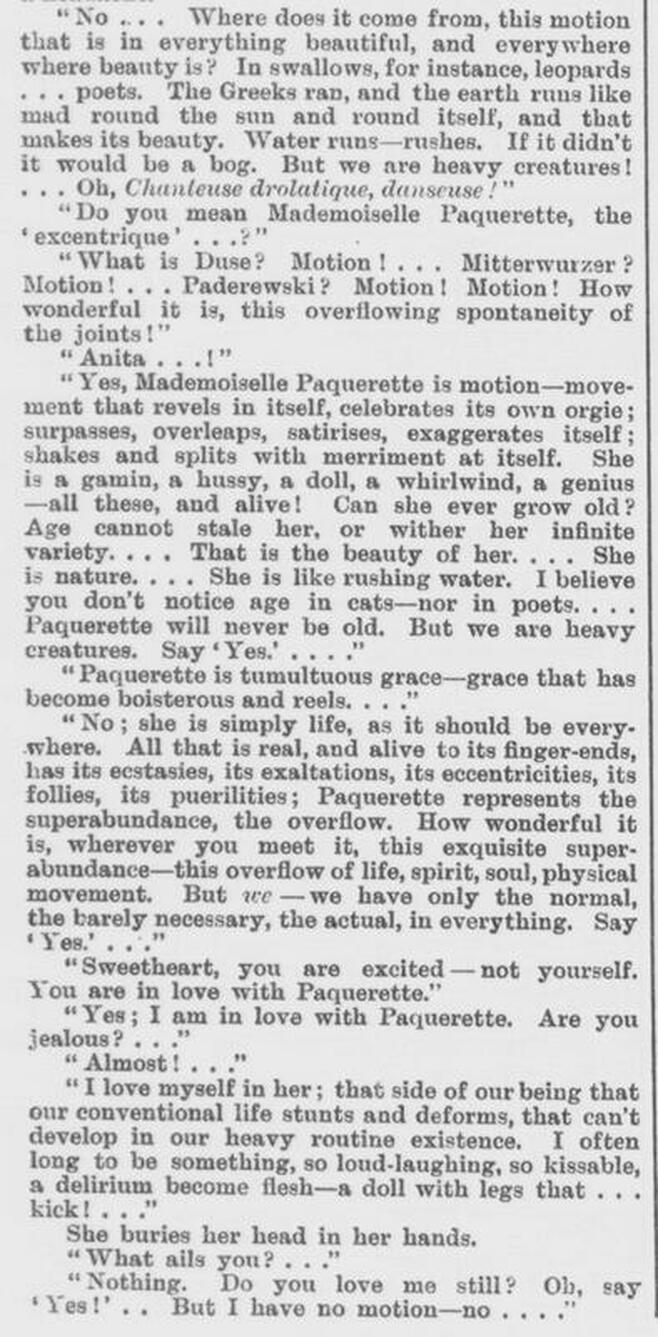the real Pâquerette

There has been considerable confusion around the identity of a stage and film performer called Pâquerette, arising chiefly from the fact that between 1890 and 1960 there were at least 12 different performers who used that sobriquet. I attempted to dispel this confusion in an earlier post, here. I have recycled materials from that post for this one, adding the new information I have found about the performer who to me is the most important and interesting of all these Pâquerettes. This new post is solely about her, the 'Real Pâquerette', a star of the music hall in the 1890s and a regular performer in films between c.1910 and 1930.
All details of her biography that I have been able to find are presented below, starting with the official record of her birth:
Mathilde Gabrielle Chabriais was born on May 9th 1873 in Périgueux, Dordogne, to parents Lucien Théodore Chabriais and Louise Eugénie Michel, 'tous deux artistes lyriques', both singers. They were married in Paris on December 23rd 1869, while they were living at 13bis Rue Norvins, in Montmartre. Of their other children the only one who concerns us is Mathilde's sister Blanche, born three years earlier in Abbeville, Somme.
To the record of birth have been added details of her marriage on August 17th 1905, at the mairie of the 10e in Paris. This was her second marriage.
To the record of birth have been added details of her marriage on August 17th 1905, at the mairie of the 10e in Paris. This was her second marriage.
In 1923 Mathilde Chabriais, using only the name Pâquerette, gave an interview to the journal Mon Ciné in which, though she mostly spoke of her involvement in Sarah Bernhardt's last film, she gave details of her early career:
'I've been working since I was four. I started in the Music-Hall, singing romances and living on raw onions and scraps of bread.' She describes an enthusiastic audience of students at the Alcazar d'été, who encored her at length and postponed the entry of the popular singer Paulus, and how as a consequence she was hired for a vast sum by an American who had been in the audience. She says she got married in the U.S., came back and continued in music-hall before moving on to the theatre and cinema.
During this period she was known variously as Pâquerette, Mlle Pâquerette, sometimes Mme Pâquerette and often Gabrielle Pâquerette. She did play at the Alcazar d'été in 1892, as did Paulus, though I can't find a record of them being on the same bill. In his memoirs Paulus speaks very highly of her: 'she was very pretty and happily made herself ugly in grotesque costumes; her comedy was irresistible.' This photograph, reproduced in Paulus's memoirs, shows what she was like before she transformed herself into a grotesque:
During this period she was known variously as Pâquerette, Mlle Pâquerette, sometimes Mme Pâquerette and often Gabrielle Pâquerette. She did play at the Alcazar d'été in 1892, as did Paulus, though I can't find a record of them being on the same bill. In his memoirs Paulus speaks very highly of her: 'she was very pretty and happily made herself ugly in grotesque costumes; her comedy was irresistible.' This photograph, reproduced in Paulus's memoirs, shows what she was like before she transformed herself into a grotesque:
And these are images of her from this same period, the mid 1890s:
Gabrielle Pâquerette was a big star in the 1890s and still a draw for a decade or so after. Aged seventeen or so she began appearing at Les Ambassadeurs, drawing comment for her very long arms. In 1892 she appeared at the Trocadero in London, and in 1893 played New York:
In Dances With Darwin, 1875-1910: Vernacular Modernity in France (2008), Rae Beth Gordon discusses Gabrielle Pâquerette's act:
|
Through advertisements and notices in newspapers it is possible to trace the stages in Gabrielle Pâquerette's career up to around 1912.
In an 1893 interview to the Boston Globe she said that she had been on the stage about fourteen years. In 1891 she appeared at the Folies-Bergère in Paris and in 1892 debuted at the Trocadero in London. In 1893 she was appearing in New York, at Tony Pastor's theatre and then at Koster and Biel's. In New York she got married for the first time. The American newspapers report on her marriage in detail. Here, from the Chicago Daily Tribune, is the most succinct of those reports: The story was told more floridly in the New York Times:
|
|
The newspaper gives her age as 'about twenty-one', as does the New York record of the marriage, whereas she was in fact only nineteen.
The story of Gabrielle escaping her mother's financial contriol by marrying appears to be the last time her parents featured in her life. Her new husband didn't feature for long in her life either: in 1894 she returned to Paris with him and she performed at the Jardin de Paris and the Folies-Bergère. She went back to the U.S. in November 1895 and stayed till the following May. When she returned to Paris she left her husband Louis Verande in New York; this seems to mark their separation. Verande stayed in New York to become a theatre manager, eventually coming to Paris and establishing himself as a theatrical impresario and, by 1918, a film producer.
Gabrielle's career on the stage peaked around 1901-04. She starred in a revue called Paris-Snob at the Parisiana, a theatre where she performed regularly until 1904, appearing also at the Olympia. She continued to play abroad, appearing at the Berlin Wintergarten and at the Tivoli in London in 1902:
Between the early 1890s and 1903 her appearance changed somewhat. This poster from 1901 includes illustrations that correspond more to the mid 1890s, around a central picture suggesting embonpoint:
A review of her act at the Casino des Lilas in Bordeaux in 1903 describes her as fat:
These postcards date from some time after 1905:
In November 1903 Gabrielle Pâquerette featured on the front page of almost every French newspaper after she was attacked by a former lover, the mime artist Max Illy. Here is how the crime and trial were reported in the Daily Telegraph (November 20th and December 24th 1903):
The French newspapers covered the story of the attack in greater detail. Apparently Gabrielle and Max Illy - real name Charles Berteaux - had lived together for seven years or so. Their cohabitation must have begun very soon after her return from New York in May 1896; according to Illy they separated in October 1903.
His violent attack on Gabrielle and the subsequent trial were Illy's moment of greatest fame. He received a suspended sentence of one year, and continued to perform as a singer and actor until at least 1920.
His violent attack on Gabrielle and the subsequent trial were Illy's moment of greatest fame. He received a suspended sentence of one year, and continued to perform as a singer and actor until at least 1920.
Many of the French newspapers commented on Gabrielle's on her physique, sometimes critically: 'grande et plantureuse personne' (Le Petit Parisien); 'cette grande belle fille' (Le Figaro); 'grande et forte personne, peu jolie sous ses bandeaux botticellesques qui vont mal à sa large figure' (L'Intransigeant).
Here are two samples of how the French oress covered the affair:
Here are two samples of how the French oress covered the affair:
Gabrielle was thirty at the time of the attack, Illy was thirty-five. The man she replaced him with was eleven years younger. Her new lover isn't identified in the reports, but it was probably the man she married eighteen months later, a packer ('emballeur') called Georges Maréchal. The marriage record gives for both the address 127 Rue du Faubourg Saint Martin, which was where Gabrielle was living when Illy attacked her. The marriage record also indicates that they divorced in 1917.
(I have found no record of Gabrielle's divorce from Louis Vérande, but since she mentions her American marriage in the 1923 interview I assume it wasn't just conveniently forgotten.)
(I have found no record of Gabrielle's divorce from Louis Vérande, but since she mentions her American marriage in the 1923 interview I assume it wasn't just conveniently forgotten.)
The period of Gabrielle Pâquerette's success as a music hall artiste runs from 1892 to around 1907. For much of this period posters, advertisements and reviews often specified that they were referring to 'la vraie Pâquerette'. This was because, soon after Gabrielle became famous, another artiste began to appear on stage as Pâquerette, imitating her style and songs. This other performer was none other than Gabrielle's elder sister Blanche. Notices in Le Mirliton of January 26 and February 2 1894 alerted readers to the deception:
The second of these notices finishes by saying that 'until now Blanche Pâquerette sang with her husband, and has only in the last few days received permission from her sister to perform in her genre.' In March 1894 the same journal publishes a 'rectificatif', making clear that 'Pâquerette (the real one) has never given her sister Blanche Pâquerette permission to perform in her genre, and certainly not to use her name and her posters'. This didn't stop Blanche pursuing a career as an imitator of her sister, as we can see from this account of her appearance in New York in March 1895: 'Blanche Pâquerette, one of the drollest and most eccentric of Parisian singers, made her American debut yesterday at Proctor's and was much applauded. She has an odd personality, with vivacity and humor, and strongly suggests her famous sister who was here a year or two ago.'
Just how strongly Blanche's act suggested that of her sister can be seen by comparing her publicity postcard, below left, with images from her sister's posters:
Just how strongly Blanche's act suggested that of her sister can be seen by comparing her publicity postcard, below left, with images from her sister's posters:
The lesser Pâquerette was born Blanche Emilienne Chabriais on February 28th 1870, in Abbeville (Somme). The parents are listed on the birth record as café singers:
The first mention I have found of Blanche as a performer is from May 1890, when she is using her second name Emilienne and the family name Chabriais. Other mentions of a Mlle Chabriais from 1890 playing in the provinces I think refer to Blanche:
I deduce from this notice that by the end of 1890 Emilienne Chabriais, still associated with the Folies-Bordelaises, is now appearing under the pseudonym used by her sister:
In the early 1890s she also appears as part of 'Les Saintôt-Chabriais, duettistes excentriques'. I haven't been able to find out anything about the man in the double act, though he may be the 'artiste lyrique' Joseph Ernest Saintôt (born 1859).
In January 1894 she is referred to as Bl. Pâquerette in the mention of her appearance at L'Horloge on teh Champs Elysées; in December 1894 she is described as 'l'exhilarante Blanche Pâquerette' at Paris's Alcazar d'hiver.
Blanche's less brilliant career continued in parallel with that of her sister, more often in the provinces. Her appearance at the Scala in Lyon in 1896 was reviewed somewhat laconically by the brilliantly named (and no doubt pseudonymous) Ramsé de Késanlik: 'Blanche Pâquerette imitates well enough the real Pâquerette' (L'Art lyrique, 17.5.1896). In December 1898 she was at the Pépinière in Paris, copying exactly her sister's act ('un numéro en tous points semblable à celui de la Pâquerette de Parisiana' - L'Art lyrique 18.12.1898). Her November 1898 appearance in Tours was in fact advertised as 'B. Pâquerette, comique excentrique de Parisiana', claiming the prestige of the better-known venue. Such behaviour prompted her sister to publish this notice to theatre directors:
In January 1894 she is referred to as Bl. Pâquerette in the mention of her appearance at L'Horloge on teh Champs Elysées; in December 1894 she is described as 'l'exhilarante Blanche Pâquerette' at Paris's Alcazar d'hiver.
Blanche's less brilliant career continued in parallel with that of her sister, more often in the provinces. Her appearance at the Scala in Lyon in 1896 was reviewed somewhat laconically by the brilliantly named (and no doubt pseudonymous) Ramsé de Késanlik: 'Blanche Pâquerette imitates well enough the real Pâquerette' (L'Art lyrique, 17.5.1896). In December 1898 she was at the Pépinière in Paris, copying exactly her sister's act ('un numéro en tous points semblable à celui de la Pâquerette de Parisiana' - L'Art lyrique 18.12.1898). Her November 1898 appearance in Tours was in fact advertised as 'B. Pâquerette, comique excentrique de Parisiana', claiming the prestige of the better-known venue. Such behaviour prompted her sister to publish this notice to theatre directors:
|
|
Mme Gabrielle Pâquerette, the real one, from Parisiana, Folies Bergère etc., currently in Saint Petersburg, continuing her tour abroad having been in Moscow, Christiania, Berlin, awaiting her debuts in Bucharest, Stockholm, etc., etc., requests that MM the Directors do not confuse her with her sister who has taken her name and sings her genre under the name B. Pâquerette of Parisiana. Mlle B. Pâquerette is currently at the Pépinière.
|
Reports of Blanche's performances are rare after 1898, though in August 1903 she did make the newspapers after collapsing in the street during a heatwave. In December 1908 she appeared at the Alhambra singing comic songs but using her real name, Blanche Chabriais. In September 1910 she appeared in a Montmartre hall, again as Blanche Chabriais. We might think that she had heeded her sister's warnings about using her stage name, but in June 1912 Blanche again made the newspapers when she went to court against the directors of the Nouveau Cirque, who in January had hired her for their new revue, thinking she was 'the real Pâquerette'. On discovering that they had hired Blanche, not Gabrielle, they dismissed her, but she went to court on the grounds that she had offered her services in good faith, under her known stage name Blanche Pâquerette. She was awarded 600 francs in damages.
The Nouveau Cirque revue did in the end feature Gabrielle Pâquerette, and made a strong point of the fact that this was the real one.
After 1912 the only reference to Blanche Emilienne Chabriais, aka Blanche Pâquerette, I have found is the register of her death aged 63 on April 7th 1933, at the Salpêtrière hospital, 13e. She is listed as 'sans profession' and 'célibataire':
The Nouveau Cirque revue did in the end feature Gabrielle Pâquerette, and made a strong point of the fact that this was the real one.
After 1912 the only reference to Blanche Emilienne Chabriais, aka Blanche Pâquerette, I have found is the register of her death aged 63 on April 7th 1933, at the Salpêtrière hospital, 13e. She is listed as 'sans profession' and 'célibataire':
She was buried in the cemetery at Thiais.
Unlike her sister, Mathilde Gabrielle Chabriais aka Gabrielle Pâquerette did not sink into obscurity after 1912. In 1911 she reoriented herself towards boulevard theatre, joining the company at the Folies-Dramatiques on the Boulevard Saint Martin. By this time she has foregone all glamour to play the role of a corpulent mother-in-law. The reviews in Comoedia and La Presse of her debut in Fruits d'amour are explicit on this point:
'Pâquerette, the formidable, 230-pound mother-in-law...'; 'the immense Pâquerette, the fat star of our first music-halls. Only this artiste-emerita could have so comically incarnated the character of Belle-Maman...'.
A Comoedia article from October 1911 reminisces about the Ambassadeurs music hall of fifteen years before, reproducing an Ambassadeurs programme from 1896 and asking where are its stars now:
It evokes the current fame a number of these acts, including Polaire and Louis Maurel, and mentions that Pâquerette is now in La Reine de Golconde at the Folies-Dramatiques. What it doesn't say about any of these three is that each had developed a sideline to their theatrical career, performing for the cinematograph. Maurel had a substantial rôle in Méliès's 1905 Le Raid Paris-Monte Carlo, and Polaire had appeared in at least two films for Pathé, Moines et guerriers (1909), La Tournée des geands-ducs (1910), and made one film in Germany, Zouza (1911).
By 1911 Gabrielle Chabriais was regularly making films for Pathé, though if I am right in recognising her behind the beard in the Max Linder film Amoureux de la femme à barbe, this phase of her career started in 1909:
By 1911 Gabrielle Chabriais was regularly making films for Pathé, though if I am right in recognising her behind the beard in the Max Linder film Amoureux de la femme à barbe, this phase of her career started in 1909:
I have been researching her film career in order to extricate it from the listings that combine her appearances with those made by another actress who called herself Madame Pâquerette, the woman who was in Renoir's French Cancan and made her first film appearances in the 1930s.
In the interview she gave to Mon Ciné in 1923, Pâquerette summarised her early film career thus:
|
|
... I gave up the music hall for the theatre and the cinema.
At that time we used to make little films, rushed off in two or three days. The action was, you remember, somewhat disjointed, and I got several paste-board houses landing on my head. I'm none the worse for it. From a film with Max Linder, Max et sa belle-mère, I came back stuffed like a Christmas turkey. That was also my speciality with my friend Prince Rigadin. Since then I have been Mme Boche in L'Assommoir, Remondios in Sarati le terrible, Maria del Carmen's mother in Aux jardins de Murcie, I was with Sarah Benhardt in La Voyante and was Gisèle's mother in Luitz-Morat's Petit Ange et son Pantin. |
The interview is accompanied by stills from these films, as well as from La Résurrection du Bouif. This is the image from Max et sa belle mère:
As far as I can work out from the interview, existing filmographies and the evidence of my own eyes, Gabrielle Chabriais, known in the 1920s as Madame Pâquerette, made the following films. I have put an asterisk next to titles where I do not have conclusive ocular or documentary evidence:
Amoureux de la femme à barbe (Pathé 1909)
*Prix de vertu (Albert Capellani for Pathé 1911)
Rigadin et la doctoresse (Georges Monca for Pathé 1911)
*Rigadin poète (Georges Monca for Pathé 1911)
*La Suggestion du baiser (Georges Monca for Pathé 1911)
*Sa Majesté Grippemiche (Georges Denola for Pathé 1912)
Le Ménage Dranem (Pathé 1912)
Rigadin riche, Rigadin pauvre (Georges Monca for Pathé 1912)
*Sherlock Holmes roulé par Rigadin (Georges Monca for Pathé 1913)
Caza, l'amour et les pommes de terre (Pathé 1913)
Max et sa belle-mère (Pathé 1914)
Le Pari de Papillon (Eclipse 1914)
*La Joyeuse Aventure du Grand-Hôtel (1919)
L'Homme du large (Marcel L'Herbier 1920)
L'Assommoir (Maurice de Marsan et Charles Maudru 1921)
*Les As de l'écran (Rastrelli 1921)
La Résurrection du Bouif (Henri Pouctal 1922)
Sarati le terrible (Louis Mercanton 1923)
Aux jardins de Murcie (Louis Mercanton et René Hervil 1923)
La Voyante (Louis Mercanton et Léon Abrams 1923)
*Le Diamant vert (Pierre Marodon 1923)
Petit ange et son pantin (Luitz-Morat 1923)
La Rue du pavé d'amour (André Hugon 1923)
La Cabane d'amour (Juliette Bruno-Ruby 1924)
Le Baiser de Polycarpe (Charles Servaës 1924)
Le Criminel (Alexandre Ryder 1926)
Mare Nostrum (Rex Ingram 1926)
Le Jardin d'Allah (Rex Ingram 1927)
*Le Chauffeur de mademoiselle (Henri Chomette 1927)
*Florette et Patapon (Palermi 1927)
La Venenosa (Roger Lion, 1928)
Quand l'ombre descend (Gennaro Dini 1929)
I have seen two films that are listed in one or other filmography but in which I haven't seen anyone who resembles Pâquerette: Rigadin n'aime pas le vendredi 13 (Pathé 1911) and Don Quichotte (Pathé 1913). Jaques Richard's filmography combines the films of this Pâquerette with that of another actress, and I can't be sure which Pâquerette it is who appears in the 1931 film Paris Béguin - the copy I have seen of that film is to poor for me to recognise anyone.
Amoureux de la femme à barbe (Pathé 1909)
*Prix de vertu (Albert Capellani for Pathé 1911)
Rigadin et la doctoresse (Georges Monca for Pathé 1911)
*Rigadin poète (Georges Monca for Pathé 1911)
*La Suggestion du baiser (Georges Monca for Pathé 1911)
*Sa Majesté Grippemiche (Georges Denola for Pathé 1912)
Le Ménage Dranem (Pathé 1912)
Rigadin riche, Rigadin pauvre (Georges Monca for Pathé 1912)
*Sherlock Holmes roulé par Rigadin (Georges Monca for Pathé 1913)
Caza, l'amour et les pommes de terre (Pathé 1913)
Max et sa belle-mère (Pathé 1914)
Le Pari de Papillon (Eclipse 1914)
*La Joyeuse Aventure du Grand-Hôtel (1919)
L'Homme du large (Marcel L'Herbier 1920)
L'Assommoir (Maurice de Marsan et Charles Maudru 1921)
*Les As de l'écran (Rastrelli 1921)
La Résurrection du Bouif (Henri Pouctal 1922)
Sarati le terrible (Louis Mercanton 1923)
Aux jardins de Murcie (Louis Mercanton et René Hervil 1923)
La Voyante (Louis Mercanton et Léon Abrams 1923)
*Le Diamant vert (Pierre Marodon 1923)
Petit ange et son pantin (Luitz-Morat 1923)
La Rue du pavé d'amour (André Hugon 1923)
La Cabane d'amour (Juliette Bruno-Ruby 1924)
Le Baiser de Polycarpe (Charles Servaës 1924)
Le Criminel (Alexandre Ryder 1926)
Mare Nostrum (Rex Ingram 1926)
Le Jardin d'Allah (Rex Ingram 1927)
*Le Chauffeur de mademoiselle (Henri Chomette 1927)
*Florette et Patapon (Palermi 1927)
La Venenosa (Roger Lion, 1928)
Quand l'ombre descend (Gennaro Dini 1929)
I have seen two films that are listed in one or other filmography but in which I haven't seen anyone who resembles Pâquerette: Rigadin n'aime pas le vendredi 13 (Pathé 1911) and Don Quichotte (Pathé 1913). Jaques Richard's filmography combines the films of this Pâquerette with that of another actress, and I can't be sure which Pâquerette it is who appears in the 1931 film Paris Béguin - the copy I have seen of that film is to poor for me to recognise anyone.
Below are images from films featuring Madame Pâquerette, the real one:
There is a gap in Pâquerette's filmography between 1914 and 1919. The war evidently interrupted her film career, and there are no appearances on the stage noted by the press during this period. Reports in U.S. newspapers in 1927 on Rex Ingram's film Mare Nostrum give background on some of the supporting cast, including the information that Pâquerette was working on the trams in 1917. 5800 women worked as tram operators in Paris during the war (my thanks to my colleague the historian James Connolly for that insight).
Perhaps more surprising than Pâquerette's contribution to the war effort is the New York Times's comment that in 1927 she was 'a slim little thing'. This is not apparent from any of her other film appearances in the 1920s, and is not how Michael Powell remembers her in his autobiography - he had acted in the two Rex Ingram films in which Mme Pâquerette also appeared: 'Rex was talking to a mountainous Frenchwoman […]. I heard him call her Madame Pâquerette.' Six pages later he again calls her 'mountainous', and in his reminiscences of The Garden of Allah he refers to her 'grotesquerie'.
Madame Pâquerette's last definite film credit is from 1929, and there are no mentions in the press of her appearing on the stage in the 1920s.
Mathilde Gabrielle Chabriais died on January 21st 1931, at the Lariboisière hospital, 10e. The record of her death describes her as 'sans profession', divorced from Georges Maréchal, and resident at 16 Rue Nicolet, in Montmartre:
Mathilde Gabrielle Chabriais died on January 21st 1931, at the Lariboisière hospital, 10e. The record of her death describes her as 'sans profession', divorced from Georges Maréchal, and resident at 16 Rue Nicolet, in Montmartre:
The 'Histoire de Paris' information panel outside her house does not mark the former home of Mathilde Gabrielle Chabriais, dite Pâquerette, star of the Parisian music hall stage in 1890 and for the next fifteen years; rather, the panel (which has now disappeared) commemorates the residence here of another Mathilde, Mathilde Mauté de Fleurville, who in 1870 married Paul Verlaine.
Gabrielle Pâquerette was buried in the cemetery at Pantin. I don't know whether the inscription on her tomb refers to her life as an artiste of stage and screen; I don't even know if the tomb is still there. I shall go see when I next visit Paris, and also find out about the tomb of her sister Blanche, in the cemetery at Thiais.
Appendix 1
I have found several images of Gabrielle Pâquerette and reproduced them all in this post. There is one image I haven't found and which I much regret not being able to see. In the catalogue for Steinlen's first exhibition in May 1894, at la Bodinière, one of the entries reads: 'Mlle Pâquerette, danseuse grotesque. Etude.' We know that this is a study of Gabrielle and not Blanche because in February 1897 Mlle Pâquerette wrote to Steinlen asking for this pastel, which he had promised to give her. Her letter was signed 'G. Paquerette la vraie'. Here is the entry for that letter in the catalogue for the BN's 1953 Steinlen exhibition:
Steinlen's study of Gabrielle Pâquerette seems to be lost.
Appendix 2
Gabrielle Pâquerette also made an impression on the Viennese Modernist Peter Altenberg. In his 1904 volume Wie ich es sehe there is sketch called 'Café chantant' where a couple discuss her act in relation to the poetry of movement. An English translation of this text had been published in The Speaker in 1897 (November 6th):
Acknowledgements
I am indebted to Greg Philip for information that put me on a right track for this research. I strongly recommend his blogposts on 'lost cinema' such as this, at 'A Lost Film', on the actor Charles de Rochefort, and this, at 'Film perdu', on Sarah Bernhardt's last film.
Without the wealth of resources made available online by the BNF at Gallica, this kind of research would be almost impossible. I'm very grateful to Gallica and strongly recommend following them on Twitter:
https://twitter.com/GallicaBnF
Acknowledgements
I am indebted to Greg Philip for information that put me on a right track for this research. I strongly recommend his blogposts on 'lost cinema' such as this, at 'A Lost Film', on the actor Charles de Rochefort, and this, at 'Film perdu', on Sarah Bernhardt's last film.
Without the wealth of resources made available online by the BNF at Gallica, this kind of research would be almost impossible. I'm very grateful to Gallica and strongly recommend following them on Twitter:
https://twitter.com/GallicaBnF
